NURSING

DNP student Mattie Ellenson named Emerging Rural
MINNESOTA A publication of the University of Minnesota School of Nursing SPRING/SUMMER 2024 14 Creating a pathway for rural providers to improve American Indian care 06 Developing a pain management program for rural veterans 30 Alum Emily Carroll leads the launch of opioid use disorder clinic BRINGING SPECIALIZED WOMEN’S HEALTH CARE TO RURAL MINNESOTA
Health Leader
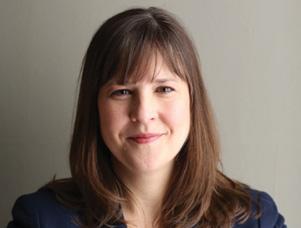
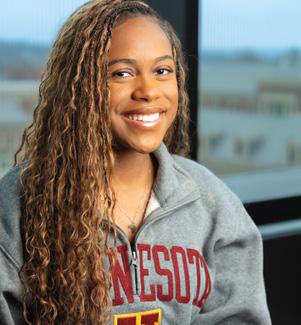

14 New report examines risk factors associated with maternal morbidity, mortality
Research conducted as part of the NIH Pathways to Prevention Program helps identify research gaps in key health topics 16 Discrimination drives desire for representation
Tumani Jackson says DNP is preparing her to serve where change is needed





DNP student Mattie Ellenson named Emerging Rural Health Leader
As CNO, Margaret Kalina, BSN ’78, is committed to advancing
Read Minnesota Nursing online at www.nursing.umn.edu/magazine
To receive a notice when the current issue is posted on the school’s website, send an email to nursenews@umn.edu.
This publication is available in alternative formats upon request. Direct requests to the managing editor at nursenews@umn.edu.
The University of Minnesota is committed to the policy that all persons shall have equal access to its programs, facilities, and employment without regard to race, color, creed, religion, national origin, sex, age, marital status, disability, public assistance, veteran status, or sexual orientation. The University of Minnesota is an equal opportunity educator and employer.
2 | MINNESOTA NURSING 34 16 14 SPRING/SUMMER 2024
ON
THE COVER 18 Bringing specialized women’s health care to rural Minnesota
34 Keeping rural health
healthy
care
rural health care SECTIONS 04 From the Dean 06 Research 11 Education 24 Outreach 37 School News 48 Alumni News FOLLOW US www.facebook.com/umnnursing www.x.com/umnnursing www.instagram.com/umnnursing
www.linkedin.com/school/umnnursing www.youtube.com/user/umnnursing
UNIVERSITY OF MINNESOTA SCHOOL OF NURSING
OUR VISION
Optimal health and wellbeing for all people and the planet.
OUR MISSION
To generate knowledge and educate diverse leaders to shape the future of nursing and advance equitable health care to improve the health and wellbeing of all.
DEAN
Connie White Delaney, PhD, RN, FAAN, FACMI, FNAP
ASSOCIATE DEAN FOR ACADEMIC PROGRAMS
Susan Gross Forneris, PhD, RN, CNE, CHSE-A, FAAN
SENIOR EXECUTIVE ASSOCIATE DEAN FOR RESEARCH
Diane Treat-Jacobson, PhD, RN, FAAN
ASSOCIATE DEAN FOR FACULTY AFFAIRS
Wendy Looman, PhD, APRN, CPNP-PC
ASSOCIATE DEAN FOR NURSING AND HEALTH POLICY
Margaret Moss, PhD, JD, RN, FAAN
COOPERATIVE CHAIRS
Jenna Marquard, PhD
Anne Chevalier McKechnie, PhD, RN
Erica Schorr, PhD, RN, FAHA
DEAN’S NATIONAL BOARD OF VISITORS
David Aanonson, pastor (ret.); Clara Adams-Ender, chief nurse executive, Army Nurse Corp. (ret.); Cyrus Batheja, National Medicaid Vice President - Policy and Clinical Solutions UnitedHealthcare Community & State; Jeannine Bayard, United Health Group (ret.); Michael Bird, past president, American Public Health Association; Shonda Craft, dean, School of Health and Human Services, St. Cloud State University; Jessica Drecktrah, chief nursing officer, Faith Community Nurse Network; Melanie Dreher, dean emeritus, Rush University College of Nursing; Peter Klein, CEO, Educated Change; Rahul Koranne, CEO, Minnesota Hospital Association; Richard Norling, senior fellow, Institute for Healthcare Improvement; Laura Reed, chief nurse executive and COO, M Health Fairview; Jeannine Rivet, executive vice president, UnitedHealth Group (ret.); Michael Rohovsky, Associate Corporate Office of Science & Technology, Johnson & Johnson, (ret); Franklin Shaffer, president and chief executive officer, CGFNS, (ret.); Jessica Sylvester, nursing executive and chief executive officer, Call Light Health; Dee Thibodeau, senior executive in information technology; Charlotte Weaver, former senior vice president and chief clinical officer, Gentiva Home Health & Hospice; and Cathleen Wheatley, president, Atrium Health Wake Forest Baptist Medical Center and senior vice president of clinical operations.
DIRECTOR OF STRATEGIC COMMUNICATIONS
Steve Rudolph
SENIOR EDITOR
Brett Stursa
PHOTOGRAPHERS
Darin Kamnetz, Tom Steffes
DESIGNER
Tammy Rose
CONTACT US
Minnesota Nursing University of Minnesota School of Nursing 5-140 Weaver-Densford Hall 308 Harvard Street S.E. Minneapolis, MN 55455
Email: nursenews@umn.edu Website: www.nursing.umn.edu
Minnesota Nursing is published semi-annually by the University of Minnesota School of Nursing for alumni, faculty, students and friends of the school.
©2024 Regents of the University of Minnesota. All rights reserved.
Learning from Indigenous food systems
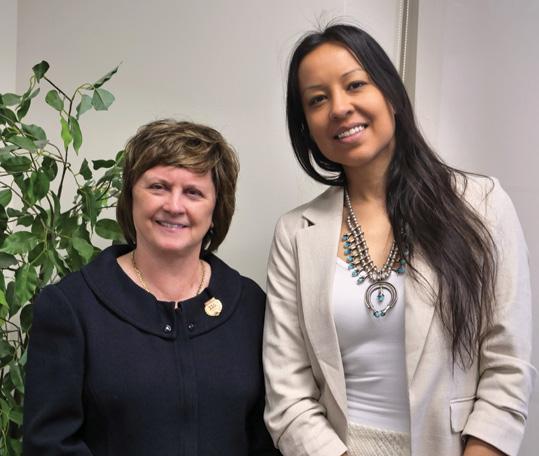
Lyla June Johnston, PhD, delivered the 4th annual Planetary Health Lectureship Remembering our Ecological Purpose: Indigenous Food Systems and the Promise of Homo Sapiens, which detailed Indigenous food systems and advocated for a mind shift to better tend the land. The lecture was held in January and kicked off the school’s 115th anniversary celebrations. Johnston is pictured with Dean Connie White Delaney, PhD, RN, FAAN, FACMI, FNAP.
www.nursing.umn.edu | 3
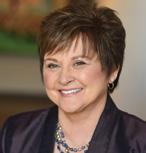
FROM THE DEAN
We celebrate 115 years of ‘the educated spirit of the nurse’
Dear Friends,
115 years ago, Richard Olding Beard led the effort to found a school of nursing at the University of Minnesota in what would become the first such school established within an institution of higher learning. Beard believed that educating nurses, rather than training them as had been the practice, would help society recognize the worth of human life, conserve human health and provide for social justice. This vision resonates throughout our 115 years, including today. As I read this issue of Minnesota Nursing, I kept returning to Beard’s ideal for “the educated spirit of the nurse” in story after story.
University of Minnesota School of Nursing students and alumni (in partnership with our faculty and staff) are having a profoundly positive impact on health locally to globally. In this issue we’re highlighting several who are using their education to improve care in rural Minnesota. The cover story features DNP student Mattie Ellenson whose efforts to bring specialized women’s health care to rural Minnesota earned her the Emerging Rural Health Leader Award. We highlight recent DNP grad Emily Carroll who is serving patients seeking care for opioid addiction as lead nurse practitioner at the HealthFinders Collaborative in Faribault, Minnesota. We spotlight BSN alum Margaret Kalina leading Alomere Health
to become the first Minnesota hospital named one of the top 20 rural community hospitals in the nation.
Join us in celebrating how a new agreement with Great Plains Area Indian Health Service is creating a pathway for rural providers to improve American Indian care. We explore how Earl E. Bakken Center for Spirituality and Healing researchers are developing a comprehensive pain management program for rural veterans, who have more severe pain than the average person but less access to care. And we highlight the research of Carrie Neerland and team that aims to impact the grave national health challenge of maternal mortality and morbidly through the NIH Pathways to Prevention Program.
As always, we appreciate your continued readership and support. We welcome your reflections, suggestions, and shared wisdom to advance our school and this magazine.

In gratitude,
Connie White Delaney Professor and Dean
4 | MINNESOTA NURSING
PARTNERING FOR HEALTH
New nurses at M Health Fairview gain valuable patient experience through innovative
virtual reality technology
In an era where advancements in health care are rapidly evolving, the need for well-prepared and adaptable nurses is paramount. M Health Fairview launched a groundbreaking Nurse Residency Pilot Program at M Health Fairview University of Minnesota Medical Center in late 2023 to revolutionize the way new nurses are trained. One of the group’s first sessions was held at the School of Nursing’s Bentson Healthy Communities Innovation Center to experience how immersive virtual reality (VR) technology benefits new nurses.
In addition to hands-on clinical experience with patients and guidance from senior nursing staff, nearly 30 members of M Health Fairview’s Nurse Residency Pilot Program used Oculus VR headsets to complete simulations of patients with simple to complex health issues that are regularly treated in acute care settings. They were given the autonomy to assess, diagnose, and treat simulated patients on their own — experiences they may not have had yet in a care setting.
“There’s a lot happening in health care right now where nurses are in situations they’ve not been in before,” says Assistant Professor Cynthia Bradley, PhD, RN, CNE, CHSE, director of simulation at the School of Nursing. “Our goal is to
help nurses feel prepared and confident to practice in health care today.”
Bradley leads the Big 10 Practice-Ready Nursing Initiative, which is funded by a grant from the American Nurses Foundation as part of its Reimagining Nursing Initiative. School of Nursing BSN seniors were introduced to the VR models this fall. Bradley saw the potential for the simulations to benefit new nurses as well and shared the idea with M Health Fairview through the school’s academicpractice partnership, or collaboratory, with the health system.
The VR modules transported the new nurses into realistic health care settings where they practice multi-tasking in high-stress situations, accessing patient records, strengthen prioritization and time management skills, and receive immediate feedback. There is hope that the pilot program and technology will improve nurse retention at M Health Fairview.
“What we’ve heard early on in this pilot was, ‘I was the nurse. I was in charge. I got to make decisions and I felt safe to make those decisions,’ which then translates into confidence,” said Katie Pitzl, MSN, RN, NPD-BC, assistant manager of clinical education and learning at M Health Fairview. “I just have high hopes for where this can go for our profession.”

Pitzl hopes it will also support nurses to have more realistic expectations of clinical practice to ultimately improve nurse retention across their hospitals.
“It can feel really scary as a new graduate nurse to take care of a patient that’s so sick, so early in your career. So if you can practice making mistakes and you can learn from your mistakes, you can get the support and encouragement you need to carry that forward into your practice.”
PARTNERING FOR HEALTH is a recurring feature that highlights a school partnership working to advance health care to improve the health and wellbeing of all.
www.nursing.umn.edu | 5
M Health Fairview Chief Nursing Officer Maria Raines and Director of Simulation Cynthia Bradley.
GOING THE DISTANCE
Researchers are developing a comprehensive pain management program for rural veterans, who have more severe pain than the average person but less access to care
by Kevin Coss
Chronic pain is a big issue for those who have served in the military.
About 77% of veterans report pain control among their top three priorities in primary care, while two-thirds report that pain significantly limits what they can do and drives them to frequently seek health care.
For those veterans living in rual areas, the picture gets more complicated. Accessing safe and effective care for pain can be difficult. Veterans in rural areas are prescribed more opioid medications than their urban counterparts, and long-term use of these painkillers can lead to addiction or even death through accidental overdose.
“In short, rural veterans are more severely impacted by pain but have fewer options for care,” says Roni Evans, DC, PhD, director of the Earl E. Bakken Center for Spirituality & Healing’s Integrative Health and Wellbeing Research Program (IHWRP). “There is an opportunity to better connect them to non-drug,
complementary and integrative health approaches that address pain in a more cohesive way.”
Evans is collaborating with two Veterans Administration (VA)-affiliated researchers to develop and test a program to better deliver care for chronic pain to rural veterans. The team aims to develop a 12-week program called Reaching Rural Veterans: Applying Mind-Body Skills for Pain (RAMP) that includes one-on-one health coaching, video lessons, group discussions and exercises to manage pain in both the mind and the body.
The project will be supported by over $4 million in anticipated funding from the National Institute of Nursing Research, part of the National Institutes of Health, as part of the Helping to End Addiction Long-term (HEAL) Initiative.
Instead of relying on medication, the program will draw on evidence-based practices to help veterans understand their pain better, learn cognitive behavioral strategies that change how they view and respond to that pain, and practice exercises that involve movement, mindfulness meditation and other
6 | MINNESOTA NURSING
RESEARCH
mind-body skills, like progressive muscle relaxation and guided imagery to improve their quality of life.
ADDRESSING BARRIERS THAT RURAL PATIENTS FACE
VA patients living in rural areas have unique challenges beyond what their urban-dwelling counterparts experience and are more likely to be affected by pain, says Diana Burgess, PhD, the lead principal investigator on the project, director of the VA Advanced Fellowship Program in Health Services Research at the Minneapolis Veterans Affairs Healthcare System, and professor of medicine at the University of Minnesota.
“Rural VA patients receive over 30% more opioids than urban VA patients, are less likely to receive comprehensive and specialty pain care, in part, due to lack of access, and are less likely to use self-management interventions for pain,” Burgess says. “Our intervention is specifically designed to address barriers that prevent rural-dwelling VA patients from engaging in non-drug, selfmanagement interventions for pain.”
LEARNING FROM PARTICIPANTS
Over the first phase of the project, the research team will develop community partnerships and pilot test the program.
Katherine Hadlandsmyth, PhD, a coprincipal investigator on the study as well as a clinical psychologist and associate professor in the Department of Anesthesia at the University of Iowa Carver College of Medicine, said the input of partners within the VA as well as community groups will help the team design the program to both fulfill national pain care priorities and fit within the day-to-day operations of a busy medical center.
“Working closely with VA partners at both the national leadership level and the local clinician level will ensure that we are building the RAMP intervention
• • •
“In short, rural veterans are more severely impacted by pain but have fewer options for care.”
–
Roni Evans, director of the Earl E. Bakken Center for Spirituality & Healing’s Integrative Health and Wellbeing Research Program
in a way that it can subsequently be delivered clinically, should we find it to be efficacious,” says Hadlandsmyth, who is affiliated with the Veterans Rural Health Resource Center at the Iowa City VA. “Meanwhile, including community group representatives offers critical insights into how to engage with varied rural veteran populations and also how to then meet the specific needs of these subsets of veterans.”
During the second phase, the team will conduct a larger study involving 500 patients in the VA health care system to measure how effective the new program is compared to standard care patients have typically been receiving. They will also work with partners to determine how to grow the program within the VA’s national Whole Health System initiative so that it can be expanded to serve rural veterans across the country, including those in underserved and marginalized groups.
If the study shows the program to be successful, the VA will be well equipped to implement it on a larger scale.
“We want to ensure that our intervention is serving the needs of a wide range of rural veterans with chronic pain,” Hadlandsmyth says.
www.nursing.umn.edu | 7
NEW REPORT EXAMINES RISK FACTORS ASSOCIATED WITH MATERNAL MORBIDITY, MORTALITY
Research conducted as part of the NIH Pathways to Prevention Program helps identify research gaps in key health topics
The U.S. faces a grave — and worsening — public health challenge related to maternal mortality and morbidity.
Despite spending more on maternal care than any other country, the U.S. has the highest rate of maternal mortality (the death of an individual while pregnant or within the first six weeks after pregnancy ends) among high-income countries. Black women are three times as likely to be affected, and Indigenous women are twice as likely, compared to white women.
While an estimated 700 people die annually from pregnancy-related complications, instances of maternal morbidity — which the Centers for Disease Control and Prevention (CDC) defines as life-threatening complications of childbirth and pregnancy that undermines a pregnant person’s functional ability — is also a public health crisis, and it disproportionately affects people of color.
Despite the scope and gravity of this public health crisis, previous efforts to explain the factors driving maternal mortality and morbidity have fallen short. A new report
conducted through the University of Minnesota School of Public Health Minnesota Evidence-Based Practice Center including School of Nursing Assistant Professor Carrie Neerland, PhD, APRN, CNM, FACNM, aims to fill this gap by undertaking a comprehensive review of academic studies focused on risk factors associated with maternal morbidity and mortality during the prenatal and postpartum periods.
“Systematic reviews are considered the gold standard and are the best tool we have to examine and synthesize evidence,” says Neerland. “However, we identified many gaps in the available evidence.”
The research was conducted as part of the National Institutes of Health Pathways to Prevention (P2P) Program, which helps identify research gaps in key health topics. The researchers sought to understand population-level increases in maternal mortality and morbidity by examining studies that analyzed social and structural determinants of health. Social determinants of health represent the broader conditions in which people live their lives and include factors like access to health care, socioeconomic and educational status, physical environment and social support networks.
8 | MINNESOTA NURSING
Written by a team of interprofessional researchers, including School of Public Health Associate Professor Mary Butler, PhD, MBA, who served as principal investigator for the project, the report informed a P2P workshop held to discuss the topic of maternal mortality and morbidity.
Researchers exhaustively searched academic databases for observational studies examining exposures related to social and structural determinants of health and at least one health or health care-related outcome for pregnant and birthing people. The main insights and recommendations in the report include the following:
• While the studies broadly covered social-structural determinants of health for pregnant and birthing people, the determinants they identified represent only a subset of potential factors of interest and did not address interdependence of risk factors, including biological or medical risk factors.
• The studies reviewed in the report covered maternal risk factors broadly, including identity and discrimination issues, socioeconomic status, violence, trauma, psychological stress, structural institutional factors, rural and urban differences, environmental conditions, comorbidities, and health care use factors.
• The limited depth and quality of available research within each risk factor domain — including racism and other forms of discrimination — impeded the researchers’ ability to understand pathways connecting social-structural determinants of health and maternal health outcomes.
• The report found an unexpectedly large volume of research on violence and trauma relative to other potential social determinants of health for pregnant people.
• Among the maternal health outcome categories in the studies (which included hypertensive disorders, gestational diabetes, cardiometabolic disorders, depression, other mental health or substance use disorders), depression and other mental health outcomes represented a large proportion of the health outcomes captured.

In addition to the full report, the team of researchers published an article in Obstetrics & Gynecology, which condenses the report for clinicians including OB/GYNs and midwives. Neerland, who was lead author of the Obstetrics & Gynecology article, says it was important that the research was disseminated in various formats.
“The hope is that it can impact future research because we identified many gaps in the research related to the social and structural determinants of health related to maternal mortality and morbidity,” says Neerland.
LEARN MORE
Read the full report at z.umn.edu/maternalmorbidity. Read the of Obstetrics & Gynecology article at https://z.umn.edu/evidencemap
The original article, written by Virgil McDill for the School of Public Health website, can be read at z.umn.edu/maternalviolence
www.nursing.umn.edu | 9
Carrie Neerland
LEVERAGING GENERATIVE AI TO MODERNIZE NURSING EDUCATION
Michalowski urges nurse educators to harness the potential of generative AI
by Brett Stursa
The proliferation of new generative artificial intelligence (AI) tools can be challenging for nurse educators and clinicians to keep up with, as the potential benefits also come with new challenges.
Associate Professor Martin Michalowski, PhD, FAMIA, examines generative AI in nursing education and provides recommendations for nurse educators to optimize its use in recent publications.
Michalowski’s most recent article, The ChatGPT Effect: Nursing Education and Generative Artificial Intelligence, published in the February issue of the Journal of Nursing Education, examines generative AI in nursing education more broadly and urges nurse educators to harness its potential.
Prompt engineering when using generative AI in nursing education, published in the January issue of Nurse Education in Practice, makes recommendations to integrate prompt
LEARN MORE
Read The ChatGPT Effect: Nursing Education and Generative Artificial Intelligence at z.umn.edu/chatgptnursing
Read Prompt engineering when using generative AI in nursing education at z.umn.edu/nursingprompt
engineering — the process of refining questions to get better results — in nursing education.
“Generative AI is one of the key required competencies and it needs to be integrated into the education nurses receive both as concepts to understand and as tools to use,” says Michalowski. “Similar to concepts in machine learning, natural language processing, automated reasoning, and other AI subfields, generative AI is transforming the provision of care. Therefore, it is important that nurses understand how to use it, and how its use impacts health care systems, providers and patients.”
Currently, he says that the most effective uses of generative AI in nursing classrooms is creating mock patientrelated data and providing patient scenarios for practice.
“When applying learned theories or tools where patient-related data is needed, generative AI models are very useful for building synthetic data in different formats, like tables, free text notes, etc.,” says Michalowski. “Additionally, generative AI enables critical thinking through the creation of patient use cases/scenarios. This application is one of the few where hallucinations — presenting output patterns as fact while they are clinically or factually incorrect — is acceptable. Students need to apply what they learned

and use critical thinking to identify inaccuracies and contradictions in the use case. The instructor can also tailor the output use cases by providing important context for the learning exercise.”
Michalowski says it’s imperative nurse educators integrate AI competencies into their classrooms to ensure students are well equipped as future clinicians.
“Nurses have an incredible opportunity to lead health care’s transformation of clinical care with AI. They touch all aspects of the care process, understand the clinical problems and interface with patients. They are positioned to be the bridge between AI developers, health care practitioners and stakeholders,” says Michalowski. “However, to fully realize this potential they need basic AI competencies that aren’t currently part of their education.”
10 | MINNESOTA NURSING
Martin Michalowski
BSN STUDENTS
UTILIZE IMMERSIVE VR SIMULATION TO PREPARE FOR REALITIES OF ACUTE CARE NURSING
Autonomous decision making, caring for multiple patients are key learning experiences
by Brett Stursa
Seniors in the Bachelor of Science in Nursing (BSN) program are utilizing virtual reality (VR) in novel ways meant to prepare them for the realities of practicing as an acute care nurse, as the school launches the Big 10 Practice Ready Initiative.
“It feels pretty real,” says BSN student Julia Barger. “You can tell how the patient looks and you can assess them however you want. It’s really cool.”
The Big 10 Practice Ready Nursing Initiative, led by Simulation Director Cynthia Bradley, PhD, RN, CNE, CHSE, is being conducted at four Big 10 sites. In addition to the University of Minnesota, students at University of Michigan, Purdue University and University of Nebraska are also participating.
Students engage in five immersive VR modules over a semester, beginning with one patient and gradually increasing to
five patients. They use an Oculus headset and controller as they maneuver through an acute care setting.
“This is a unique experience for nursing students because they are able to go in and manage multiple patients in a completely risk-free space,” says Jessica McGahan, of Oxford Medical Simulation.
“As a nurse, you’re going to have lots of people, lots of plates spinning at once. You need to be able to go in and manage an increasing workload and this is really giving them that preparation for practice.”
BSN student Julia Barger liked the challenge of being able to take care of multiple patients because in clinical learning she’s only assigned one. “I think its real cool technology. I think it gives us a really unique perspective that maybe not other nursing schools will have,” she says.
continued on page 13
www.nursing.umn.edu | 11
EDUCATION

BSN seniors engage in the first of five immersive VR modules over the semester, beginning with one patient and gradually increasing to five patients.

continued from page 11
The scenarios are developed to mimic real life, with a phone ringing or another patient needing meds, which is an element students say they appreciated.
“You, as a nursing student, are going to have to learn and adapt to a changing situation like in real life,” says BSN student Alfonso Amores. “I think it’s really neat. I can see the real use for it.”
BSN student Conrad Noel liked that the VR simulation made him respond in real time. “It’s a little bit more on-the-fly thinking. You can call the provider, you can talk to the charge nurse.”
The immersive VR simulations allows students to be autonomous decision makers for patients, which is something they haven’t experienced before.
“This is the only time in their nursing program where they can act as the nurse alone and that is something for obvious safety reasons. We can’t do that in clinical,” says Bradley. “In VR, they make their own decisions. Many students said they forgot they were in a classroom because they felt like they were right there with that patient. Some of them talked about the stress they felt of making the decisions for their patient.”
The technology allows students to talk with patients and care for them with equipment and supplies found in a typical patient room.
“We’re using VR as a way to practice our skills and it’s really cool experience to have,” says BSN student Sydney Zander.
• • •
“In VR, they make their own decisions. Many students said they forgot they were in a classroom because they felt like they were right there with that patient. Some of them talked about the stress they felt of making the decisions for their patient.”
– Cynthia Bradley, simulation director and Big 10 Practice Ready Nursing Initiative principal investigator
After students complete their VR scenario, faculty debrief with students in groups where they are guided through reflective thinking over the decisions they made in the scenario.
“This will improve their confidence,” says Bradley. “I think it will improve their competence so that when they transition into practice they’re truly ready for nursing practice and they know what this is going to look like when they get there.”
The Big 10 Practice Ready Nursing Initiative is supported by the American Nurses Foundation Reimagining Nursing Initiative, which funded 10 projects to improve practice readiness in the U.S.
BSN student Elianna Steenwyk is grateful the new technology is supporting her education. “It’s awesome that we get to do this and learn in this way and just have more opportunity to learn,” she says.
www.nursing.umn.edu | 13
Photo: Darin Kamnetz
Watch a video from the classroom at z.umn.udu/NursingVR LEARN MORE
CREATING A PATHWAY FOR RURAL PROVIDERS TO IMPROVE AMERICAN INDIAN CARE
New agreement opens doors to clinical learning in Great Plains Area Indian Health Service
by Brett Stursa
Students at the University of Minnesota School of Nursing now have the opportunity to have clinical experiences at Indian Health Service clinics and hospitals after a collaborative agreement was established between the Great Plains Area Indian Health Service and the University of Minnesota School of Nursing.
The agreement facilitates the clinical learning experiences in 21 Indian Health Service Units and Tribal managed Service Units in North Dakota, South Dakota, Nebraska and Iowa for nursing students in the Bachelor of Science in the Nursing and Doctor of Nursing Practice programs.
The Indian Health Service, an agency within the Department of Health and Human Services, is responsible for providing federal health services to American Indians and Alaska Natives. Its mission is to
raise the physical, mental, social and spiritual health of American Indians and Alaska Natives to the highest level.
Erica Amador, BSN, RN, SANE-A, an enrolled member of the Turtle Mountain Band of Chippewa and chief nurse executive for the Pine Ridge Service Unit, approached the school about partnering after learning of the school’s Doctoral Education Pathway for American Indian/Alaska Native Nurses, which supports AI/AN nurses in completing a doctoral degree at the University of Minnesota.
“I thought that it would be a good pathway to spread the word about our agency and the opportunities available in this unique location and unique population,” says Amador.
As chief nurse executive for Pine Ridge, she oversees the administration of nursing services for the hospital and three clinics that serve 26,000 active patients in South Dakota. “We have a significant nurse vacancy rate because of our rural location so my goal was to build a pathway to attract students to learn here and discover the opportunities for them here after they graduate.”
While the agreement includes all of Great Plains Area, it’s expected that many of the clinical experiences will occur at Pine Ridge.
14 | MINNESOTA NURSING
• • •
“It’s an interesting place to be where there are a lot of patient contacts. Students will see how higher acuity patients are cared for in a rural setting, which is different than an urban setting where a variety of services are available at the same location.”
– Erica Amador
“It’s a great opportunity for students to learn about the culture of the community and to experience a very rural part of South Dakota. It’s a win-win for each of us,” says Misty Wilkie, PhD, RN, FAAN, Turtle Mountain Band of Chippewa/Métis and director of the Doctoral Education Pathway for AI/AN Nurses at the School of Nursing. Since signing the agreement with Great Plains Area, the school has established new agreements with Oklahoma City Area IHS, Phoenix Area IHS, Navajo Area IHS and Albuquerque Area IHS.
Many of the opportunities at Pine Ridge are appropriate for DNP students in the nurse practitioner, nursemidwifery and nurse anesthesia programs.
“We have a very busy emergency room that sees 80-110 patients a day with a high acuity of injuries and illness. It’s an interesting place to be where there are a lot of patient contacts,” says Amador. “Students will see how higher acuity patients are cared for in a rural setting, which is different than an urban setting where a variety of services are available at the same location. It’s different experience.”
Whether students decide to provide health care within Indian Health Service after graduation or not, they’ll be better prepared to care for American Indian patients regardless of their location. “Given that 70% of Native Americans live off of the reservation, whether they
come to work on a reservation or not, they are going to care for Native Americans. Students coming here to do an immersion experience will add so much to their knowledge and comfort with our population. That’s really exciting,” says Amador.
Already, Amador is serving as a preceptor for a DNP student in the health innovation and leadership specialty and as a board member for the School of Nursing Center for Indigenous People, Health and Nursing of North America.
“I’m really excited about the whole experience with the School of Nursing. I’m proud of the University for the Pathway Program and assisting Native health care providers in reaching that doctoral level. It’s going to lend improvement to access and inclusion of Native nurses at higher administrative levels.”
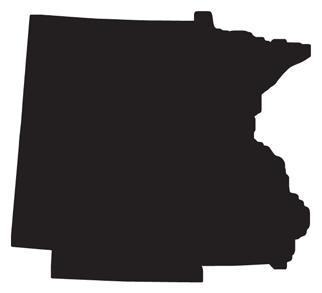
www.nursing.umn.edu | 15
NORTH DAKOTA SOUTH DAKOTA MINNESOTA NEBRASKA IOWA Bismarck Fargo Grand Forks Minneapolis St. Paul Sioux Falls Pierre Rapid City Pine Ridge Omaha Lincoln Sioux City Cedar Rapids Des Moines
The Great Plains Area Indian Health Service map.
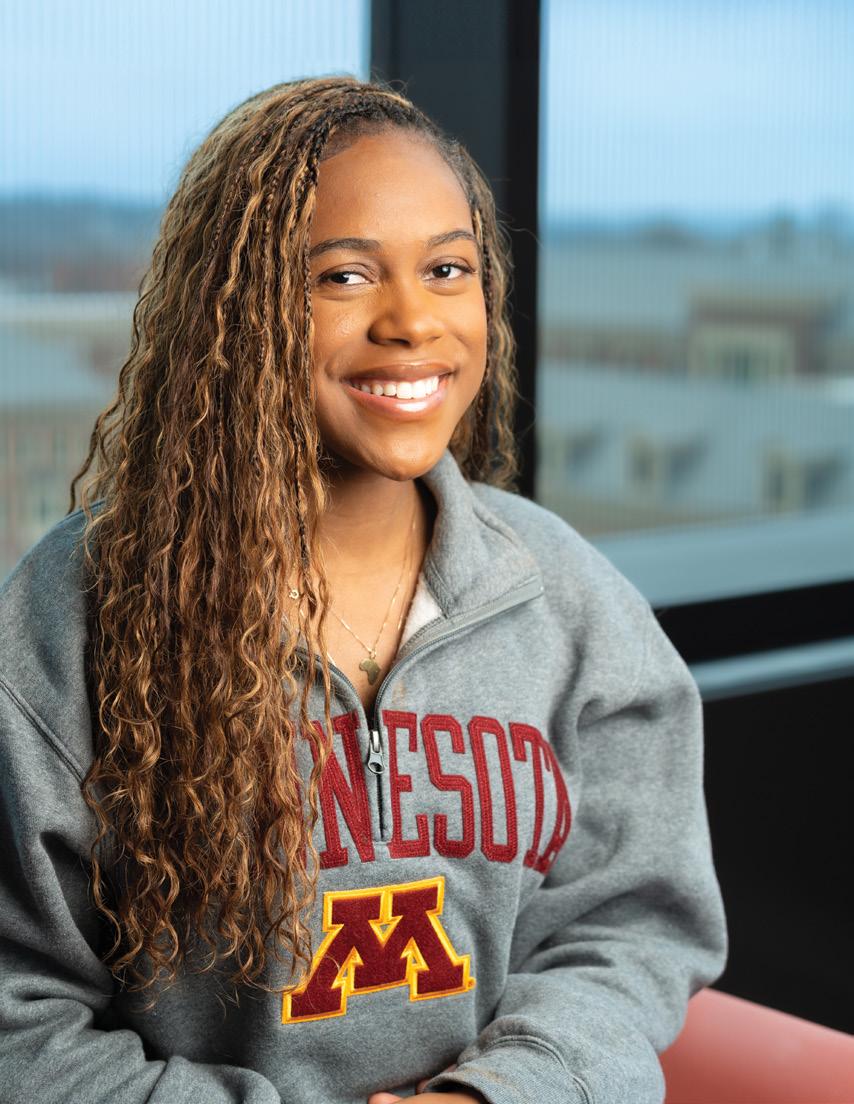
“As a DNP student nurse I learned to be the voice and the advocate for those who do not have a voice,” says Tumani Jackson, who is a student in the health innovation and leadership specialty.
by Brett Stursa
DISCRIMINATION DRIVES DESIRE FOR REPRESENTATION
Tumani Jackson says the DNP is preparing her to serve where change is needed
The discrimination Tumani Jackson, BSN, RN, saw Black patients experience while she was an emergency and cardiac nurse in North Carolina set her on a path to earn a doctoral degree to be able to serve in a leadership role.
“I have always been interested in leadership and advocacy, and, especially being a Black woman, into diversity, equity and inclusion. I had witnessed a few things in the hospital,” says Jackson. “There needed to be more education. People who look like me needed to be advocated for, as a lot of time there aren’t a lot of us who look like me in roles of leadership. That’s the main reason why I decided to go back to school.”
Jackson chose the University of Minnesota — despite a literal allergy to the cold — because of its health innovation and leadership (HIL) specialty within the Doctor of Nursing Practice program.
“What I liked about the HIL program is that it’s so diverse. It allows you to do whatever you want. I have colleagues who focus on planetary health. For me I want to focus on diversity, equity and
inclusion and leadership in that aspect,” says Jackson.
The nerves she had applying to a school in Minnesota, particularly after George Floyd was murdered by a Minneapolis police officer, were assuaged as she got to know faculty. “I was nervous coming into the program about what kind of support I would have, would I be in this alone,” says Jackson. “The staff and faculty have been extremely amazing. They are very supportive of what you want to do.”
After Clinical Professor Teddie Potter, PhD, RN, FAAN, FNAP, got to know Jackson and her aspirations, she encouraged her to apply to be a 2023 Health Equity Scholar through the Cambridge Health Alliance and Harvard Medical School. Jackson applied and was named a 2023 Health Equity Scholar. “I had no idea that existed,” says Jackson. “They tailor things to you once they know your interests. Also, they are very supportive about being inclusive of others.”
Currently in her third year in the program, Jackson says a highlight was travelling to Cuba with HIL students and faculty. “Actually going there and meeting the people and seeing what their health care system looks like was amazing to me,” says Jackson. “Just to be able to immerse myself like that. That’s been the highlight.”
Jackson says receiving a Bentson scholarship was crucial to being able to pursue a DNP degree. The Bentson Doctor of Nursing Practice Scholarship was established by the Bentson Foundation to support DNP students, particularly those interested in serving underserved populations.
Jackson spoke of its importance at the Dean’s Scholarship Reception. “Without proper representation from BIPOC health care professionals, BIPOC patients will continue to suffer in a system that was not designed for them,” says Jackson. “As a DNP student nurse I learned to be the voice and the advocate for those who do not have a voice. As a Bentson scholarship recipient, I’ve learned that paying it forward is more than monetary. It’s me giving the power back to those who often feel powerless or hopeless.”
As she prepares to graduate, Jackson is optimistic about how she’ll utilize her new degree to change and shape health care through diversity, equity, inclusion, and policy.
“The sky is the limit. I know that I’ll be able to not only have the knowledge but the resources. I will have the confidence to be able to step into a place of work or whatever place that I feel there is a change needed and know that, number one, I have the tools.”
www.nursing.umn.edu | 17
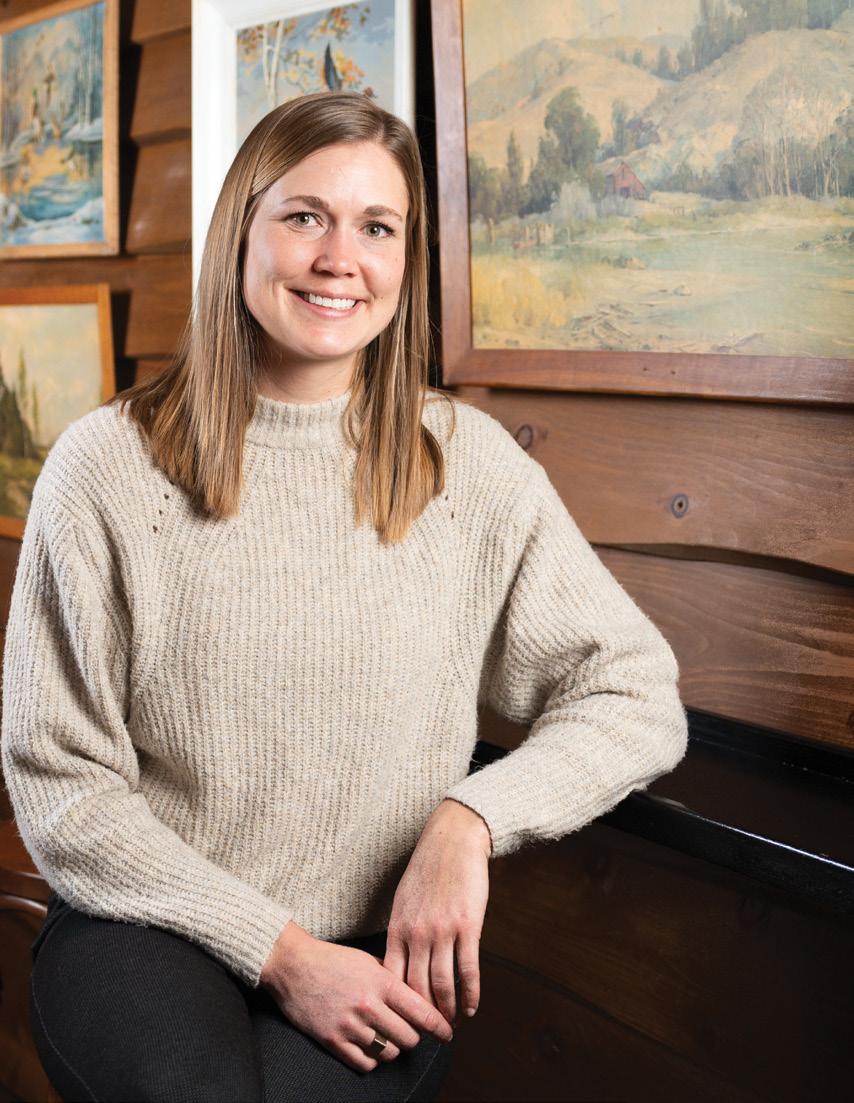
Mattie Ellenson is a member of the school’s Doctoral Education Pathway for American Indian/Alaska Native Nurses, which supports AI/AN nurses in completing a doctoral degree.

BRINGING SPECIALIZED WOMEN’S HEALTH CARE TO RURAL MINNESOTA
DNP student Mattie Ellenson named Emerging Rural Health Leader
by Brett Stursa
After a decade of caring for families — first as a labor and delivery nurse and later as a public health nurse — and after three years in classrooms and clinical rotations as a student in the Doctor of Nursing Practice (DNP) program, Mattie Ellenson is ready to bring specialized women’s health care to rural Minnesota. On the cusp of graduating in May, Ellenson says it will be an honor to provide care as a women's health care nurse practitioner near her home in Wadena.
“I think being able to bring more specialized women's care rurally is important,” says Ellenson. “There's still more traditional ways of life in rural living that make it challenging for women to get care. I think we’re starting to do a better job with pregnancy and postpartum and the struggles of those parts of a woman's life. So hopefully, we’ll get there with mid to later life issues that women are facing too.”
Her leadership in leading the charge to improve rural health has already garnered the attention of the Minnesota Rural Health Association, which named her the recipient of the Emerging Rural Health Leader Award this year.
SEEING A NEED FOR SPECIALIZED CARE FOR WOMEN
Ellenson was first drawn to nursing because of the trust people put into nurses. “It’s an honorable profession and there are many directions you can take it,” she says. She sought a DNP degree to have a greater impact on her patients’ lives. When she learned about the women’s health and gender-related nurse practitioner program at the University of Minnesota, she knew it was the right fit.
“I think what was a big draw to the program was that it was already women’s health specific and it was a doctoral program,” says Ellenson.
The program was also a good fit because she was able to complete all of her clinical placements in rural clinics, with family nurse practitioners, OB-GYNs and nurse-midwives.
“People will ask why I picked women’s health or if I limited myself too much, but my experience has made it obvious that there’s a space for a women’s health nurse practitioner with someone who has more knowledge in specific areas that affect women. I think my clinical
www.nursing.umn.edu | 19
“People will ask why I picked women’s health or if I limited myself too much, but my experience has made it obvious that there’s a space for a women’s health nurse practitioner with someone who has more knowledge in specific areas that affect women.”
– DNP student Mattie Ellenson
placements made me even more aware of the need around where I live,” says Ellenson.
As a DNP student, she partnered with the White Earth Band of Chippewa Indians on the White Earth reservation to implement rapid HIV testing at an established medication assisted treatment clinic. She led the training of 15 nurses and community health workers on conducting the rapid tests and providing counseling.
The project was particularly meaningful, as Ellenson is a descendent of White Earth Nation, where her grandpa James was an enrolled member.
Ellenson is also a member of the school’s Doctoral Education Pathway for American Indian/Alaska Native Nurses, which supports AI/AN nurses in completing a doctoral degree. As a student in the pathway program, Ellenson attended an Indigenous nursing conference, met regularly with a cohort of other Indigenous DNP students and received financial support.
“I am thankful for the opportunity that the University of Minnesota Pathway Initiative has provided me to continue to learn and enhance my cultural identity,” Ellenson said as a speaker at the Dean’s Dinner last year. “Through this initiative I have made numerous connections with students, faculty and relatives that I look forward to continuing to nurture in my final year of coursework and as a doctorally prepared Indigenous nurse.”
Ellenson will be launching her career as a women’s health nurse practitioner after she graduates in May. As a women’s health nurse practitioner, she will provide comprehensive women's health care, which includes sexual health, menopause symptoms management, well women care and prenatal/postpartum care in collaboration with midwives and OB-GYNs.
“A lot is still not talked about,” says Ellenson. “So, I think a big piece in the future rural health care is breaking down those stigmatizations or stereotypes.”
20 | MINNESOTA NURSING
• • •
WHEN CLIMATE ACTIVISM IS INSEPARABLE FROM HEALTH CARE CALLING
BSN
student Yvonne Mongare attended COP 28 in Dubai
by Susan Maas
When Yvonne Mongare, who grew up in Apple Valley, Minnesota, started living on campus at the University of Minnesota, she noticed that she’d developed a chronic cough.
“I was experiencing a lot of respiratory issues and congestion,” the second-year Bachelor of Science in Nursing student says. “My friends would bring me tea packets, and my dad bought me a humidifier.” Increasingly frequent wildfire smoke from Canada and the western U.S. in recent years — due largely to climate change — probably is a factor, Mongare believes.
Combine that with air pollution from other sources, which disproportionately impacts low-income neighborhoods with predominantly residents of color, and Mongare worries about a widespread increase in lung and heart problems. That’s one of the concerns Mongare brought with her to COP 28, the 2023 United Nations Framework Convention on Climate Change she attended in Dubai, United Arab Emirates, this past winter.
• • •
“All of my mentors are so passionate about advocating for our patients, advocating for patients experiencing health disparities.”
– Yvonne Mongare
Mongare, who first got involved in the group Climate Generation’s Youth Environmental Action network in high school, doesn’t see climate activism as a side endeavor: it’s inseparable from her calling to health care, she says. Having worked part time for over a year as a certified nursing assistant at a nursing home, Mongare has more exposure to health impacts of environmental injustice. “There are so many patients who have type II diabetes, respiratory diseases. I can clearly see how the environment is affecting people’s health and preexisting chronic conditions,” she says.
continued on page 22
www.nursing.umn.edu | 21
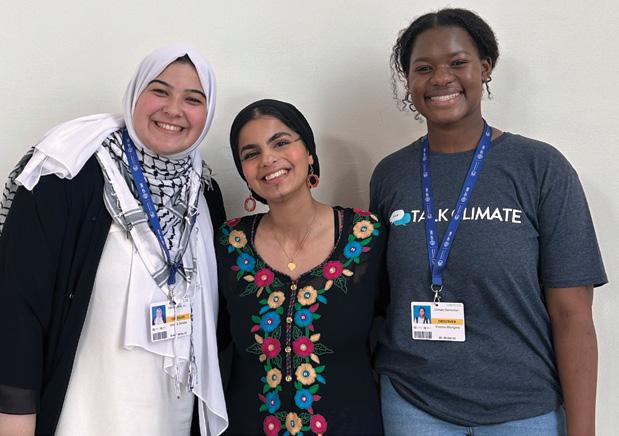
continued from page 21
The proud daughter of two nurses, Mongare decided to earn a nursing degree on her way to medical school. “I want to use my nursing degree as experience so I can have a guaranteed job postgraduation while I continue taking my medical school prerequisite courses,” she explains. Her passion for environmental justice is why Mongare was chosen as a Climate Generation delegate to the conference, which she attended with a dozen other University of Minnesota representatives.
Mongare, whose role was that of an observer, was the only University undergraduate at COP 28. Watching and listening, rather than actively helping set policy, was a challenge for Mongare. She testified last year at the Minnesota legislature, both in support of a climate justice education bill (that didn’t pass in that session) and the 100% clean electricity bill that did pass — “which was amazing,” she says.
“As a youth voice, and as a Black woman from Minnesota, I really want to make my voice heard,” Mongare says. She absorbed as much as she could, “going to many panels and workshops throughout each day. I was surprised to learn that until last year COP had never really had a climate-and-health day! I was happy to see that more people are becoming aware of how the climate crisis really intersects with health.”
One thing she learned at COP is just how paltry the U.S. contribution is to “loss and damage” funding for countries most vulnerable to climate change. “Honestly, $17.5 million is very, very small,” she says. As one of the world’s biggest contributors to greenhouse gas emissions, the country needs to do better, Mongare believes. “It’s important to have awareness of your agency as a global citizen, and what your country is doing in the world.”
22 | MINNESOTA NURSING
From left, Stanford University student Sabrina Deriche, Palestinian American climate justice activist Ayisha Siddiqa and BSN student Yvonne Mongare at COP 28 in Dubai.
Highlights of Mongare’s seven days in Dubai included meeting Hillary Rodham Clinton and Palestinian American climate justice activist Ayisha Siddiqa, a cofounder of Fossil Free University and climate adviser to the U.N. Secretary General. “It was definitely a privilege,” she says. The next U.N. climate conference is being hosted by another fossil-fuel hotbed, Azerbaijan, in November. Mongare would like to attend COP29 if she’s invited.
Mongare is grateful to professors Erin Armstrong, DNP, RN, CNE, and Linnea Benike, DNP, RN, PCCN, CNE, Dean Connie White Delaney, PhD, RN, FAAN, FACMI, FNAP, and Director of Planetary Health Teddie Potter,
• • •
“It’s important to have awareness of your agency as a global citizen, and what your country is doing in the world.”
– Yvonne Mongare
PhD, RN, FAAN, FNAP, for enthusiastically supporting her attendance at COP despite a heavy courseload.
“I’ve thought a lot about how lucky I am to be in the School of Nursing. We actually have a community,” Mongare says. “All of my mentors are so passionate about advocating for our patients, advocating for patients experiencing health disparities. I’m very lucky to be in a school that’s conscious.”

www.nursing.umn.edu | 23
An art installation outside the Al Wasl Plaza with the shoes representing the children who don't have access to human rights and who have died from extreme climate related issues.
by Brett Stursa
SEXUAL ASSAULT VICTIM SURVIVORS AND THEIR COMMUNITIES HAVE NEW TOOL TO ASSIST IN SEEKING CARE
Collaboration of Re LAB, U-Spatial and MNCASA creates new map of Minnesota resources
People seeking health care or additional assistance after a sexual assault now can access a first-of-itskind map to locate where to find help.
The map, which shows sexual assault nurse exam availability and advocacy locations across the state of Minnesota, is the result of a partnership led by Professor Carolyn Porta, PhD, RN, SANE-A, FAAN, and the Re LAB team with U-Spatial and the Minnesota Coalition Against Sexual Violence (MNCASA).
“If someone is in crisis we don’t want them digging to find who they can go to for help, because it’s a big deal that they are reaching out for help,” says Megan McKinnon, member and organization services manager for MNCASA. “We want to get them to where they
need to be as quickly as possible. It’s much nicer to have a clickable map where you can plug in where you are instead of going through a list of resources.”
MNCASA provides state-wide support and resources to 60 sexual assault programs and allies to prevent sexual violence while promoting a comprehensive, socially just response for all victim survivors.
Re LAB is a workforce development initiative supported in part by a Health Resources and Services Administration workforce grant that aims to increase the numbers and capacity of sexual assault nurse examiners (SANE) throughout Minnesota and the U.S. with a focus on rural and underserved areas. The mapping initiative was part of a technical assistance effort supporting MNCASA and agencies across Minnesota.
24 | MINNESOTA NURSING OUTREACH
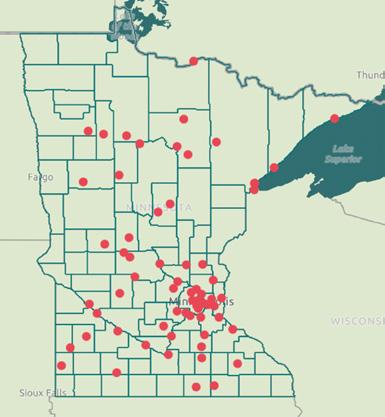
If staff or others helping a victim survivor can more readily identify resources, regardless of where the call or request is coming from, then one barrier to accessing health care and advocacy services can be removed.
“Having a spatial component has been a very powerful tool,” says Ellen Frerich, MN, RN, PHN, Re LAB project manager.
The immediate impact, she says, is that advocates and other health professionals are able to utilize the map to quickly and accurately let potential patients know their options. She says it also allows SANE trainees to identify programs close to them for potential employment.
“The story the map is telling is that we are doing better getting resources accessible to all and that we need to continue doing better,” says Porta, Re LAB principal investigator and School of Nursing professor.
The map shows sexual assault nurse exam availability and advocacy locations in Minnesota.
Creating the map was a collaborative process with U-Spatial, the University of Minnesota mapping and data visualization experts. The interprofessional collaboration was valuable in all directions, says Len Kne, MGIS, director of U-Spatial. “We approach questions in different ways,” says Kne.
McKinnon appreciates the partnership, including the training she received from U-Spatial to maintain the map that is housed on the MNCASA website.
“We feel lucky having both Re LAB and U-Spatial support this work,” says McKinnon. “We would not have been able to create a map on our own at this level.”
LEARN MORE
View the map at z.umn.edu/mncasa
Learn about Re LAB at relab.umn.edu
www.nursing.umn.edu | 25
INITIATIVE CONTINUES TO EXAMINE THE ETHICS OF AI IN NURSING
Committee takes an ethics-first approach
The steering committee for the School of Nursing-led initiative to examine the ethical implications of the use of artificial intelligence (AI) in nursing continues to have thriving discussions and move this important work forward.
The school launched the initiative last year to develop a framework for the future use of AI in nursing. The steering committee is taking an ethics-first rather than technology-first lens in its work. Committee members are focused on recognizing the high ethical standards to which nurses adhere and systematically evaluating how AI can both support nurses in upholding those ethical standards or interfere with or threaten nurses’ abilities to uphold those ethical standards.
The American Nurses Association details nine provisions within its Code of Ethics for Nurses, ranging from “the nurse practices with compassion and respect for the inherent dignity, worth, and unique attributes of every person” to “the nurse has authority, accountability, and responsibility for nursing practice, makes decisions; and takes action consistent with the obligation to promote health and to provide optimal care.”
AI has the potential to support or interfere with these ethical provisions. For example, if thoughtfully designed, AI could reduce documentation burden, freeing up more time for nurses to build patient relationships, or AI could aid nurses in developing individualized plans of care based on unique characteristics and preferences of patients and families.
If not thoughtfully designed, AI may replace human empathy and compassionate care with calculated decisions, reducing patients’ trust in nurse decision making and put the nurse-patient relationship at risk.
This committee’s ethics-first lens is providing a systematic way to better ensure AI positively impacts nursing care.
Steering Committee members include:
Connie White Delaney, PhD, RN, FAAN, FACMI, FNAP, professor and dean of the University of Minnesota School of Nursing;
Jenna Marquard, PhD, professor at the University of Minnesota and co-chair
Martin Michalowski, PhD, FAMIA, associate professor at the University of Minnesota and co-chair
Constantin Aliferis, MD, PhD, MS, FACMI, director of the Institute for Health Informatics;
Kathy Chappell, PhD, RN, FNAP, FAAN, senior vice president of Accreditation, Certification, Measurement, Quality and Research, American Nurses Credentialing Center;
Pamela Cipriano, PhD, RN, NEA-BC, FAAN, president of the International Council of Nurses;
Tracee M. Coleman, MS, RN-BC, CPHIMS, Clinical Informatics Consultant, Optum Health;
Peter Klein, BA, CEO and founder of Educated Change; Joyce Sensmeier, MS, RN-BC, CPHIMS, FAAN, senior advisor of informatics for HIMSS; Bill Torvund, Quantum Futurist;
Martha Turner, PhD, RN-BC, FAAN, historian & code scholar, American Nurses Association Code of Ethics for Nurse;
Ian Wolfe, PhD, MA, RN, HEC-C, clinical ethicist, Children's Minnesota;
Olga Yakusheva, PhD, MSE, economist and a Professor of Nursing and Public Health at the University of Michigan.
26 | MINNESOTA NURSING
DEED AWARDS GRANT TO LAUNCH PRE-LICENSURE
NURSING
APPRENTICESHIP PILOT PROGRAM
Center for Nursing Equity and Excellence
will lead the program that will support
48 nurse apprentices
The Center for Nursing Equity and Excellence (CNEE), which was launched through a partnership between the University of Minnesota and Minnesota State, was awarded a $740,000 grant from the Department of Employment and Economic Development's (DEED) to launch a Pre-Licensure Nursing Apprenticeship pilot program.
“The Pre-Licensure Nursing Apprenticeship Model is a fundamental reimagining of how we teach nursing in Minnesota. It reimagines nursing clinical education to address long standing barriers to nursing education, clinical faculty shortages and clinical space shortages. By creating a system where students can work and become nurses at the same time, we are breaking down significant barriers to careers in nursing,” says Jennifer Eccles, PhD, RN, FAADN, CNEE’s executive director.
With the launch of the program, current nursing students from the University of Minnesota, Anoka-Ramsey Community College and Minnesota North College will apply to become nurse apprentices at Allina Health or Essentia Health.
The students will be employees of the health system, earning a wage while they learn. They will serve two shifts weekly as nurse apprentices and receive paid release time to attend school. The yearlong pilot program will support up to 48 nurse apprentices, who will begin their apprenticeships in the fall semester.
A career navigator will provide individualized support to each apprentice before, during and after the apprenticeships. After graduating and obtaining licensure, apprentices are guaranteed employment at the health system they apprenticed with.
Allina Health will partner with AnokaRamsey Community College and the University of Minnesota to provide paid apprenticeships to Associate of Science in Nursing and Bachelor of Science in Nursing students. Essentia Health will partner with Minnesota North College to provide Associate of Science in Nursing apprenticeships.
CNEE is working with national partners, including the Healthcare Career Advancement Program National Center for Healthcare Apprenticeships, to learn from experiences in other states such as Vermont and Texas.
CNEE is Minnesota’s nursing workforce center and is the key to bringing together industries, stakeholders and academia to solve Minnesota’s nursing shortage in a way that reflects the diversity of Minnesotans.
CNEE’s grant award was part of the nearly $20 million in grants awarded as part of DEED’s Drive for 5 Workforce initiative, which is a new effort to prepare more Minnesotans for high-demand jobs in technology, the trades, caring professions, manufacturing and education.
CNEE ANNOUNCES EXECUTIVE COUNCIL
The Center for Nursing Excellence and Equity recently announced its Executive Council.
Valerie DeFor, executive director, The Minnesota State HealthForce Center of Excellence
Jennifer Eccles, executive director, The Center for Nursing Equity and Excellence
Ryannon Frederick, chief nursing officer, Mayo Clinic
Rhonda Kazik, chief nurse executive, system and chief nursing officer - east market, Essentia Health
Sandy Kohler, dean, Anoka-Ramsey Community College, representing Associate and Practical Directors of Nursing
Marilyn Krasowski, retired director of Education, Minnesota Board of Nursing
Joyce Miller, associate professor, Augsburg University, representing the Minnesota Association of Colleges of Nursing
Zora Radosevich, director, Office of Rural Health and Primary Care at MDH
Melanie Sullivan, chief people officer, Ecumen
Connie White Delaney, professor and dean, University of Minnesota School of Nursing
www.nursing.umn.edu | 27

The Center for Flourishing Health Care Communities hosted a music therapy event earlier this year.
28 | MINNESOTA NURSING

CREATING FLOURISHING HEALTH CARE COMMUNITIES
New partnership with University of Minnesota Rochester aims to increase recruitment, retention and flourishing of health care students and professionals
The University of Minnesota School of Nursing and the University of Minnesota Rochester have partnered to provide a testing ground for developing innovative and realistic approaches to the state’s complex nursing and health care workforce challenge. The collaboration stems from the University’s system-wide MNtersections initiative aimed at optimizing health education to increase the pipeline of well-prepared health care workers and support student wellbeing.
One component of the partnership is the newly established Center for Flourishing Health Care Communities. The center is designed to integrate applied research, practice and education for nurses and other health professionals to increase the retention and recruitment of nurses in Minnesota. Led by School of Nursing Clinical Professor Sherry Chesak, PhD, RN, a nurse scientist with Mayo Clinic, the new center builds on the University’s strong relationship with Mayo Clinic as well as the Center for Nursing Equity and Excellence, a partnership between the University of Minnesota and Minnesota State that works with every nursing school in the state and is the Minnesota’s official nursing workforce center.
“For too long the focus related to workforce retention has been placed solely on providing individuals with tools that create resiliency and focused on individuals functioning in the status quo,” says Connie White Delaney, PhD, RN, FAAN, FACMI, FNAP, dean of the School of Nursing. “This initiative and center disrupts that approach by exploring transformation of our organizations and the health care ecosystem to enable our caregivers to flourish and prosper.”
The center's focus will begin by supporting students and faculty on the Rochester campus through programming and will later expand offerings to the larger health care community. The first Flourishing Health Care Forum was hosted earlier this year. The forums are a nexus of inspiration and connection for faculty and clinicians at the forefront of initiatives promoting flourishing in health care practice, education and research. Other center offerings include creative arts workshops for students that are designed to inspire students to actively engage with and apply flourishing concepts, fostering long term adoption of practices.
“This center is a deepening of the valuable partnership between the School of Nursing and UMR, with strong potential to support the long-term wellbeing of our future health care workforce. UMR continues to prepare our graduates to solve the grand health challenges of the 21st-century and address Minnesota’s dire health care workforce needs,” says University of Minnesota Rochester Chancellor Lori Carrell, PhD.
A physical space for the Center for Flourishing Health Care Communities will soon be added on the University of Minnesota Rochester campus. This space will be dedicated to creating a culture of flourishing among health care students, health care professionals, and the environments they learn and work in by discovering groundbreaking, creative approaches that foster inclusivity, resilience, and a thriving health care ecosystem.
www.nursing.umn.edu | 29
THE NP OF SEX AND DRUGS
As a rural nurse practitioner, Emily Carroll, DNP ’20, shows where there’s a will, there’s a way
by Brett Stursa
It’s a Wednesday afternoon at the HealthFinders Collaborative in Faribault, Minnesota, which means the lead nurse practitioner Emily Carroll, DNP ‘20, APRN, CNP, will be seeing patients in the Medication for Opioid Use Disorder (MOUD) clinic.
For the last four years, the clinic has served patients seeking care for opioid addiction by providing buprenorphine, which lowers cravings and blocks the effects of opioids.
On this Wednesday afternoon in January, Carroll knows the patients she’s seeing well enough to ask about a recent vacation or upcoming dental work. While questions about cravings and dosages come up during each 30-minute appointment, most of the conversations center on other aspects of life — navigating Medicaid or how work at the assisted living facility is going.
“I love seeing a patient’s vacation photos, hearing about their families or jobs and just being a supportive listener to stories about the often interrupted path of recovery. What I am often doing is making a positive space to rebuild trust and bridges between patients and health care to make it easier for them to come back to their next appointment. If I can build that trust, patients may be more likely to talk about treatment for Hepatitis C or maybe cutting back on their methamphetamine use,” says Carroll.
After working as a primary care family nurse practitioner at HealthFinders for 10 years, Carroll returned to school and led the launch of the MOUD clinic as part of her scholarly project as a student in the post-master’s Doctor of Nursing Practice program at the University of Minnesota. Her leadership in establishing the clinic and her commitment to serving patients in Faribault recently earned her the Distinguished Humanitarian Award from the Nursing Alumni Society.
“She has undoubtedly saved countless lives, narrowed cultural disparities, expanded medical services among underinsured or uninsured patients in a rural setting, and contributed to educational efforts of the next generation,” wrote Connie Jaenicke, MSN, CNP, AOCNP, in the nomination letter.
THE NUMBERS SHOW A NEED
Prior to establishing the MOUD clinic, Rice County had year-over-year increases of opiate-related fatalities and non-fatal overdoses. Situated about 50 miles south of Minneapolis, Rice County is a blend of agriculture and industry. Both Jennie-O Turkey and Faribault Foods are major employers in Faribault, which is the county seat and has a population of about 55,000.
While there was one doctor who traveled from Hennepin County twice a month to hold a MOUD clinic in Lonsdale, it could be hard to get an appointment. Other MOUD clinics were even farther away. The distance and lack of accessible transportation were significant barriers for rural patients seeking help. Many of them had lost their driving licenses, which are expensive to reinstate, making it difficult to seek care.
continued on page 32

30 | MINNESOTA NURSING
ALUMNI SPOTLIGHT

Emily Carroll led the launch of a Medication for Opioid Use Disorder clinic as a DNP student. Four years later, it continues to meet a need in the community.
continued from page 30
“The numbers showed a real need,” says Carroll. “And then, we were all hearing more and more local stories of how difficult it was to get access to buprenorphine.”
When the Rice County Mobile Opiate Support Team received funding to expand access to opiate use disorder treatment, it supported the launch of the MOUD clinic at HealthFinders Collaborative and, later, at the Rice County Jail. “It’s really unusual that we’re able to work with the rural county jail to see patients,” says Carroll.
Since then, Carroll mentored local physicians and nurse practitioners in MOUD care and provided harm reduction and stigma-decreasing education to law enforcement members in Rice County, including three police departments and the Sheriff’s Office.
HealthFinders and the Rice County Mobile Opioid Support Team also obtained funding to ensure all of the MOUD patients have access to group therapy, inpatient/ outpatient treatment, and assistance with obtaining health insurance, paying for medication and housing.
Carroll, who graduated in 2020, says launching the MOUD clinic as her scholarly project brought depth and substance to the initiative. It also provided the structure that led to publishing an article, Implementation of office-based buprenorphine treatment for opioid use disorder, about the launch in the Journal of the American Academy of Nurse Practitioners.
“By publishing, I was able to disseminate our work and hopefully show people this can be done with a lot of will and very few resources. You can do this and, in fact, you should do it,” says Carroll.
• • •
“She has undoubtedly saved countless lives, narrowed cultural disparities, expanded medical services among underinsured or uninsured patients in a rural setting, and contributed to educational efforts of the next generation.”
– Connie Jaenicke, MSN, CNP, AOCNP
EVOLVING SERVICES TO MEET COMMUNITY NEEDS
As a community clinic, HealthFinders relies on a combination of grants, fundraising and volunteers to provide primary care, dental care and mental health care to people with limited access to health care. The clinic started in a church basement in Dundas, Minnesota, between Northfield and Faribault, in response to the lack of health care access that undocumented people were experiencing.
As needs in the community have evolved, so have services. The clinic now has a syringe exchange — a particular point of pride for Carroll — and is officially an outpatient treatment program. “That means if somebody is court ordered to go to treatment, they could receive it here in Faribault at HealthFinders, which is important because we’re the only ones that have bilingual, bicultural, Somali- and Spanish-speaking folks. There’s no other place in Rice County with that. You'd have to go up to the cities,” says Carroll, noting they were able to expand while many other treatment programs are closing.
32 | MINNESOTA NURSING

In addition to seeing patients in the MOUD clinic, Carroll sees patients for primary care and has developed a reputation of being the “NP of sex and drugs.” “I do a lot of adolescent health care. There is a lot of overlap in chemical health and sexual health,” says Carroll, who provides sex education at the Faribault High School through a Minnesota Department of Health grant for teen pregnancy prevention.
She balances her time at HealthFinders with her positon as an assistant professor in nursing at St. Olaf College. In addition she serves on several boards, including Rice County Mobile Opioid Support Team and Rice County Community and Justice Council. She is the first nurse on the Community and Justice Council, which historically had a physician representing health care.
“Caring for patients with substance use is such a good fit for the nursing role, and I’m so glad to be able to amplify that,” says Carroll. “Nurses should be at the table of health and social service-related organizations.”
FIGURING IT OUT TOGETHER
Collaboration and transparency are key to making initiatives like the MOUD clinic work, says Carroll. “I think we try not to surprise anybody with our work here. We’re completely transparent at every step, making sure the schools know what we’re doing, the police know what we're doing, social services. Because we’re so reliant on working with other people, we’ve built a lot of trust and built community as well.”
Those partnerships go hand-in-hand with being a rural health care provider immersed in her adopted home town. “It can be so helpful and inspiring to just fix it together as a community, trying to figure it out together,” says Carroll.
www.nursing.umn.edu | 33
HealthFinders Collabortative was started in a church basement in Dundas, Minnesota, in response to the lack of health care access that undocumented people were expanding. It now includes three clinics, in Faribault, pictured above, Northfield and Owatonna and offers medical, dental, behavioral health and community wellness services.
KEEPING RURAL HEALTH CARE HEALTHY
As CNO, Margaret Kalina, BSN ’78, is committed to advancing rural health care
by Colin Sokolowski
For more than four decades, one person has been at the heart of health care services for Douglas County and the Alexandria, Minnesota area.
Margaret Kalina, MPH, BSN, the vice president of patient services and chief nursing officer for Alomere Health, formerly known as Douglas County Hospital, in Alexandria has held her current role since 1991.
With more than 900 employees, Alomere Health is the largest employer in Douglas County. As a senior member of its administrative team, Kalina supervises 300 nursing department employees, along with cardiopulmonary services and the pharmacy departments.
“My goal is to provide my leaders with everything they need to do their job well,” says Kalina.
That quality of care includes nursing services provided by several different departments that Kalina oversees, including the emergency department, surgical services, and the medical/surgical/pediatrics, obstetrics, and intensive care units. It also means preparing the staff to meet the needs of the community. When respiratory
syncytial virus (RSV) rates were up in Minnesota, Kalina helped her staff study best practices to keep affected infants from being transferred out of Alexandria.
“Rural health care is the entry point,” she explains. “We have to identify our patients’ health care needs correctly and then either continue their care locally or send them off to higher levels of care elsewhere.”
During her long career, she’s had a key role in creating a new emergency department and led multimilliondollar expansions of the operating room and a new inpatient tower. She also helped establish an oncology/ chemotherapy unit and helped the hospital transition to electronic health records.
Last year, the National Rural Health Association named Alomere Health one of the Top 20 Rural and Community Hospitals in the nation — the first Minnesota hospital to garner the honor.
“It’s been a great journey to see the growth of Alexandria and the growth of our hospital,” Kalina says. “It’s amazing to see all the different specialties we are able to provide, and how health care has changed dramatically. When I started my career, many of the conditions we would
continued on page 36

34 | MINNESOTA NURSING
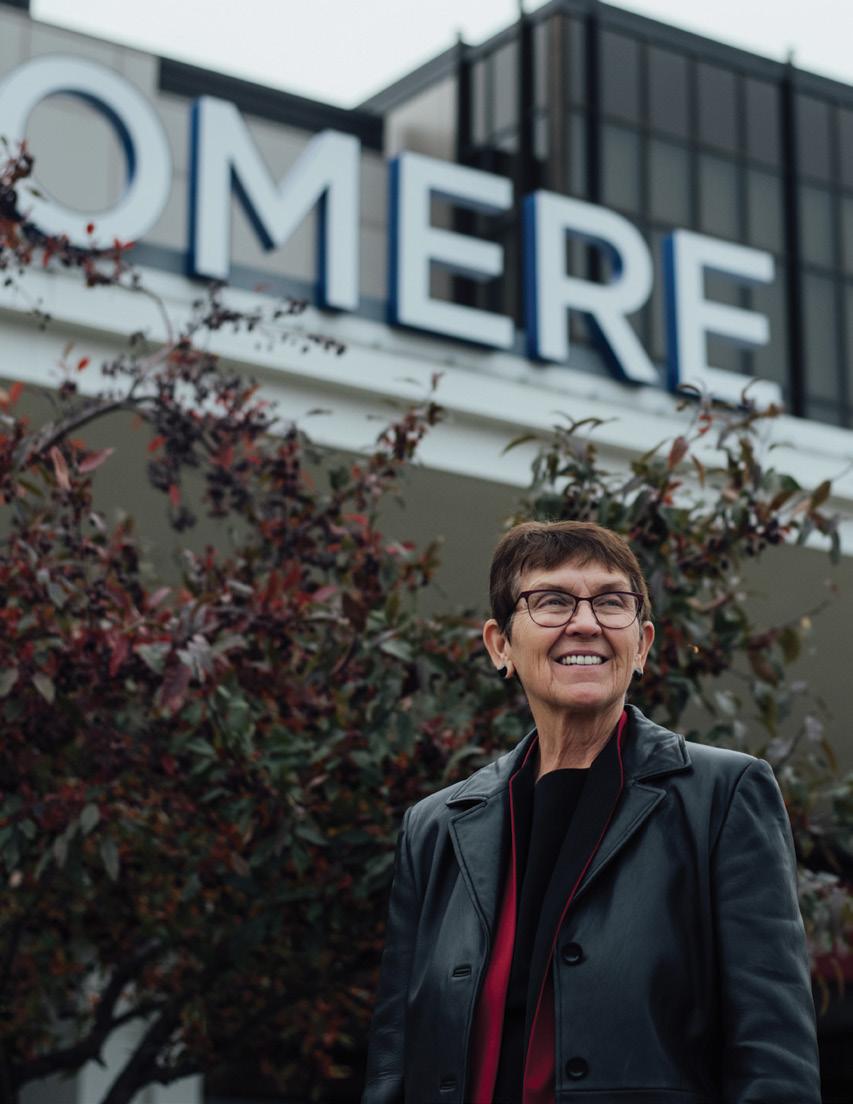
Margaret Kalina supervises 300 nursing department employees, along with cardiopulmonary services and the pharmacy departments as chief nursing officer for Alomere Health.
“I think the workforce outlook will turn around, because the best thing about nursing has always stayed the same: Whether we’re metro or rural nurses, we stand by patients and families during the most critical moments of their lives. It’s the ultimate reward.”
– Margaret Kalina
continued from page 34
see required a long inpatient stay. Now those same conditions are outpatient visits.”
Nursing programs have changed significantly, too, since Kalina earned her Bachelor of Science in Nursing at the University of Minnesota in 1978.
“In those days, it took us two full days to complete our nursing board exams for licensure. Thanks to an algorithm, it can take some students as little as 45 minutes today,” she says.
Kalina built her career as an obstetrics nurse, a public health nurse, a school nurse, and eventually as the assistant director of nursing for Douglas County Hospital. She was appointed by the governor’s office four times to serve on the Rural Health Advisory Committee, whose 15 members represent licensed health care and higher education professionals, legislative officials, and consumers. The group conducts research and advises the commissioner of health and other state agencies on important rural health issues.
Growing the state’s health care workforce is the committee’s top priority. Enrollment in nursing schools is dropping significantly in Minnesota. According to the Center for Nursing Equity and Excellence, there were 42 fewer nursing students enrolled in Minnesota’s non-metro associate degree programs this past spring
than last year. And the number of continuing students dropped by more than 500.
“Minnesota lost a huge portion of its health care workforce during the pandemic,” Kalina says. “What I fear the most is that during COVID, we as nurses went home, looked exhausted and frazzled, and our children probably looked at us and just said, ‘Wow, I’m not doing that.’”
Despite the challenges, Kalina remains optimistic that the nursing profession will bounce back. She continues to actively support health care workforce initiatives around the state, and she has no intention of retiring any time soon.
“I think the workforce outlook will turn around, because the best thing about nursing has always stayed the same: Whether we’re metro or rural nurses, we stand by patients and families during the most critical moments of their lives. It’s the ultimate reward.”
Reprinted with permission from Minnesota Alumni magazine. www.minnesotaalumni.org. Interested in joining the University of Minnesota Alumni Association? Visit umnalumni.org/join
36 | MINNESOTA NURSING
• • •
SCHOOL CELEBRATES 115TH ANNIVERSARY
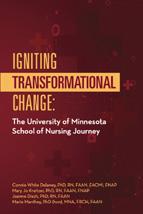
The School of Nursing is celebrating its 115th anniversary this year. Founded in 1909, the University of Minnesota School of Nursing was the first nursing program established within a university. Richard Olding Beard, MD, led the efforts, forever establishing nursing’s place in higher education. Beard passionately advocated for the advancement of nursing believing that educating nurses, rather than training them in hospital-based apprenticeship programs as was the practice, would help society
recognize the worth of human life, conserve human health and provide for social justice.
As part of the celebrations the book Igniting Transformational Change: The University of Minnesota School of Nursing Journey will be published. It is authored by Joanne Disch, Mary Jo Kreitzer, Marie Manthey and Connie White Delaney. It shares insights into the school’s transformative journey, particularly its past 20 years, and provides recommendations to schools experiencing challenges. This book informs and inspires change by inviting readers to reflect on the key cultural priorities and transformative practices of the University of Minnesota School of Nursing.
Additionally, events celebrating the school’s 115th are scheduled throughout the year.
HENNEPIN HEALTHCARE, UNIVERSITY OF MINNESOTA FORM NURSING COLLABORATORY
The University of Minnesota School of Nursing and Hennepin Healthcare Department of Nursing have formed a formal academic-practice partnership, or collaboratory, to generate, disseminate, and apply knowledge for the improvement of nursing practice, education, and patient outcomes.
Nursing collaboratories serve as an incubator for creativity and innovation. They aim to develop new strategies to enhance nursing education and professional development, research, practice, diversity, inclusion and equity, and recruit top talent into nursing.
“Hennepin Healthcare has an incredible connection to our community and we welcome the opportunity to work in full partnership with them and further advance the culturally competent care they provide so many Minnesotans” says Dean Connie White Delaney, PhD, RN, FAAN, FACMI, FNAP. “The collaboratory has the potential to elevate the incredible work Hennepin Healthcare has been doing in our community to the national level.”
According to an American Association of Colleges of Nursing and American Organization for Nursing Leadership task force, academic-practice partnerships such as the collaboratory are “an important mechanism to strengthen nursing practice and help nurses become well positioned to lead change and advance health.”
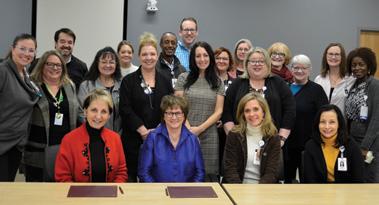
“This partnership celebrates and supports our outstanding nurses by expanding educational and professional development opportunities,” says Chief Nursing Officer Karen Strauman, DNP, MHA, MPH, NEA-BC. “Together, we will advance the nursing practice at Hennepin Healthcare, address workforce challenges by creating new career pathways and support innovative approaches to the challenges we face that will benefit our nurses and, in the end, serve our patients and our community.”
Hennepin Healthcare becomes the School of Nursing’s 10th collaboratory joining Allina Health, Children's Minnesota, Essentia Health, Faith Community Nurse Network, Minneapolis Veterans Affairs Health Care System, M Health Fairview, Mayo Clinic, Minnesota Hospital Association and PrairieCare.
www.nursing.umn.edu | 37 SCHOOL NEWS

Find the answers to the questions facing nursing and improve the health of patients and the community with a PhD in Nursing from the University of Minnesota. Our new HyFlex instruction format allows you the option to attend class in-person or remotely through video connection. Whether on campus or not, you’ll be mentored by nationally renowned faculty and provided research opportunities only a tier-one institution ranked in the top 10 can provide. Full-time students receive significant financial assistance for their first two years.
Learn more at nursing.umn.edu/PhD


38 | MINNESOTA NURSING EARN YOUR PHD THE WAY YOU WANT NEW DELIVERY MODEL OFFERS GREATER FLEXIBILITY
DENSFORD CENTER HOSTS PLANTING SEEDS OF INNOVATION COLLOQUIUM JUNE 4

The Katharine J. Densford International Center for Nursing Leadership is hosting the Planting Seeds of Innovation Colloquium on June 4 to guide participants through the process of growing an innovation seed into action. Nurses are problem solvers who use their creative ideas to develop innovations to do things differently and more effectively. The Planting Seeds of Innovation Colloquium will examine the science and process behind innovation.
Oriana Beaudet, DNP, RN, FAAN, vice president of Nursing Innovation for the American Nurses Association Enterprise and School of Nursing alum, will deliver the keynote about the importance and the presence of innovation in health care. Beaudet organized the launch of the Planting Seeds of Innovation workshop in 2015 through her Doctor of Nursing Practice scholarly project.
Panel discussions will examine innovation in research and innovative
BRIEFLY
School of Nursing Foundation Grants awarded
The School of Nursing Foundation awarded three grants. Professor Niloufar Hadidi, PhD, APRN, CNS-BC, FAHA, was awarded a Josten Grant for Co-design of a Stroke Intervention Model with African American Communities: A Focus Group Study. Assistant Professor Alice Lei, PhD, MPH, RN, was awarded a School of Nursing Foundation Faculty grant for Online intervention on lung cancer screening among high-risk smokers: A pilot intervention study. PhD Student Anna Graefe, MAN, RN, PHN, LSN, was awarded an Aydelotte grant for Evaluating health equity preparedness in baccalaureate nursing programs: A mixed methods study
systems thinking as well as innovative strategies to enhance diversity, equity, inclusion and justice.
The Planting Seeds of Innovation Colloquium will be on the University of Minnesota campus in Minneapolis. The Planting Seeds of Innovation Colloquium is designed to meet the Minnesota Board of Nursing requirements for continuing education with attendees eligible for 6.6 contact hours. To learn more and to register, visit z.umn.edu/PlantingSeeds.
Planting Seeds of Innovation was launched in 2015 in partnership with M Health Fairview to support nurse innovators, and this year marks its return since the COVID pandemic.
Participants are also invited to attend the Nursing Knowledge: Big Data Science Conference beginning the day after the colloquium, June 5-7, which will explore artificial intelligence, nursing innovations and the social/ethical implications of using technologies for nursing care.
Talley testifies on GWEP activities
Associate Professor Kristine Talley, PhD, APRN, GNPBC, FGSA, provided testimony to the Minnesota Legislative Task Force on Aging on in November 2023 about the interprofessional activities and partnerships being accomplished by the University of Minnesota’s Northstar Geriatric Workforce Enhancement Program grant to implement age-friendly care and education across Minnesota.
www.nursing.umn.edu | 39
Oriana Beaudet
BRIEFLY (CONTINUED)
School cohosts MNRS conference
The University of Minnesota School of Nursing cohosted the 48th annual Midwest Nursing Research Society (MNRS) Conference Feb. 28-March 2 in Minneapolis. Additional cohosts included Mayo Clinic, Winona State University, Minnesota State University Mankato and the University of St. Thomas. Twenty-seven University of Minnesota faculty and students shared their research at the conference through poster, paper and symposium sessions. They included faculty members Wendy Looman, Barb McMorris, Laura Kirk, Robin Austin, Priya Rajamani, Esther Moon, Jenna Marquard, Anne McKechnie, Jiwoo Lee and Camille Brown. Students included Amanda Davis, Anna Graefe, Megan Holle Whipps, Bella Xiong, Anny Smith, Meg Schoenbauer, Shivani Muthya, Alex Woelfel, Annie Bell, Malin Britt, Emily Erickson, Kelli Fee-Schroder, Tipper Gallagher, Rida Jantraporn, Marshall Muehlbauer, Sue Park and Lynn Tanner.
White Delaney receives HIMSS-ANI Nursing Informatics Leadership Award
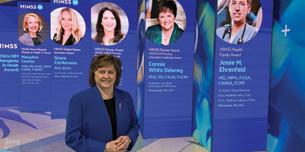
Dean Connie White Delaney, PhD, RN, FAAN, FACMI, FNAP, received the HIMSS-ANI Nursing Informatics Leadership Award for her significant leadership contributions to optimize health engagements and care outcomes through information and technology. The award is given to an individual for success and achievement as a nursing informatics leader in a provider, supplier or academic organization, or a professional society. The recipient is selected jointly by the HIMSS Board of Directors and the Governing Directors of the Alliance for Nursing Informatics. White Delaney is co-developer of the nationally recognized Nursing Management Minimum Data Set (NMDS), co-founder of the international NMDS, and co-developer of computational modeling and simulation for educational nursing administration. She co-chairs the Nursing Knowledge Big Data Science Initiative steering committee.
Densford Center hosts parallel event during UN Commission on the Status of Women
The Katharine J. Densford Center for International Nursing Leadership was selected to host a parallel event during the United Nations Commission on the Status of Women (CSW68) Forum. The panel discussion Innovative Strategies Advancing Interprofessional Education to Improve Women's Health, held in March, was moderated by Associate Professor Anne Chevalier McKechnie, PhD, RN. It included presentations and a focused discussion on how novel simulation methods, like virtual reality, high-fidelity and interprofessional simulations, can foster student learning and application of assessment skills, critical thinking, clinical decisionmaking, and ethical/cultural sensitivity. The recording can be viewed at z.umn.edu/CSW68. The Densford Center has associate member status in the Conference of Non-Governmental Organizations in Consultative Relationship with the United Nations (CoNGO).
School hosts rural APRN conference on cannabis, mental health
The University of Minnesota School of Nursing hosted the rural Advanced Practice Registered Nurse Conference Cannabis and Mental Health Care: Exploring intersections with advanced nursing practice.
The April conference covered research regarding the use of medical marijuana in psychiatric care and how recreational marijuana and medical marijuana interact with other psychiatric treatments. State laws, professional ethics and guidelines for certifying patients for medical marijuana wes also covered.
The school has hosted the conference, which is supported with a Minnesota Department of Health Professions Clinical Training Expansion grant, since 2018. “Initially it focused on psychiatric APRNs. In the last few years the material was of interest to other specialties. Consequently we welcomed other APRNs in rural areas,” says Clinical Professor Barbara Peterson, PhD, APRN, PMHCNS-BC, FNAP.
40 | MINNESOTA NURSING
AWARDS AND HONORS
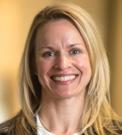
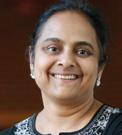

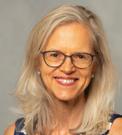
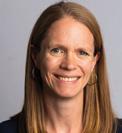
Assistant Professor Robin Austin, PhD, DNP, DC, RN-BC, FAMIA, FNAP, and Associate Professor Sripriya Rajamani, PhD, DNP, APRN, CNP, CNE, CRRN, received the Academic Forum Best Paper Award for their paper Updating of a Doctoral Nursing Informatics Program to Align with AACN Essentials, Industry Trends, and Workforce Needs. The award was presented at the Linking Informatics and Education Academic Forum Conference (LIEAF) as part of the 2023 AMIA Annual Symposium.
Associate Professor Rozina Bhimani, PhD, DNP, APRN, FNP-BC, CNE, CRRN, received a University of Minnesota award for Outstanding Contributions to Graduate and Professional Education. She received the designation of Distinguished University Teacher and was inducted into the Academy of Distinguished Teachers.
Clinical Associate Professor Laura Kirk, PhD, RN, received Sigma’s Founders Award — Elizabeth McWilliams Miller Award for Excellence in Research, which recognizes extraordinary excellence in research and its dissemination.
Professor Jenna Marquard, PhD, was inducted into the American College of Medical Informatics, which is a college of elected fellows who have made significant and sustained contributions to the field of medical informatics. Her research lies at the intersection of human factors engineering and health informatics.

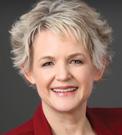

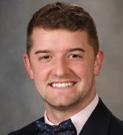
Weight Status among Minnesota Hispanic or Latino/a Youth: An Exploration of Protective Factors, written by Assistant Professor Christie Martin, PhD, MPH, RN-BC, LHIT-HP, PHN, Associate Professor Barbara McMorris, PhD, Professor Renee Sieving, PhD, RN, FAAN, FSAHM, Professor Carolyn Porta, PhD, RN, FAAN, Statistician Michelle Mathiason, MS, and Professor Jayne Fulkerson, PhD, received the Dorothy Nyswander Award from the American Journal of Health Promotion.
Associate Professor Barb McMorris’ abstract Are Adolescents’ Social Emotional Skills and Physical Activity Levels Protective Against Anxiety and Depression? Findings From the DiscoverU Afterschool Demonstration Project was named a Distinguished Abstract by the Midwest Nursing Research Society.
Population-Based Public Health Clinical Manual: The Henry Street Model for Nurses, 4th edition, co-edited by Professor Carolyn Porta, PhD, RN, FAAN, received a first place 2023 American Journal of Nursing Book of the Year Award in the Public and Population Health category. Associate Professor Melissa Horning ,PhD, RN, PHN, and Clinical Associate Professor Nasra Giama, DNP, RN, PHN, are contributing authors.
Clinical Assistant Professor Ryne Wilson, DNP, RN, OCN, was appointed to the Oncology Nursing Society Board of Directors.
www.nursing.umn.edu | 41
4 FACULTY JOIN THE SCHOOL
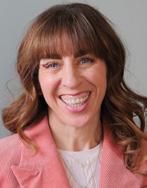
Laura Batista de Oliveira, DNP, CRNA, joined the school as clinical assistant professor and associate director of the nurse anesthesia specialty. Batista de Oliveira earned a Doctor of Nursing Practice degree in nurse anesthesia from the University of Minnesota and bachelor’s degree in nursing from Minot State University. She currently practices as a nurse anesthetist in Burnsville and her scholarship area of interest is emergency airway management.
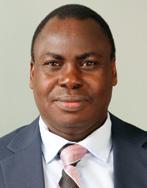
Charles Osingada, PhD, MPH, RN, joined the school as an assistant professor. He earned a PhD from the University of Minnesota and Bachelor of Science in Nursing and Master of Public Health degrees from Makerere University in Kampala, Uganda. He earned a Master of Bioethics degree from Case Western Reserve University. He taught at Makerere University Department of Nursing and served as head of the department for three years. His research focuses on expanding access to HIV services and ensuring holistic care for people living with HIV and other chronic conditions.
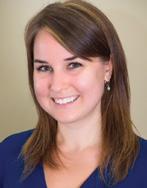
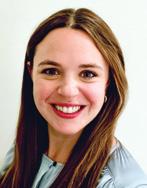
Stacey Grenier, DNP, RN, joined the school as a clinical assistant professor. She earned a Doctor of Nursing Practice degree in the integrative health and healing specialty from the University of Minnesota and a Bachelor of Science in Nursing degree from Saint Anselm College. Most recently, she served as assistant director of nursing at Mount Olivet Careview Homes.
Monica Streater, DNP, APRN, CNM, joined the school as a clinical assistant professor. She earned a Doctor of Nursing Practice degree from the University of Minnesota, a Bachelor of Science in Nursing degree from Creighton University and a bachelor’s degree from University of Wisconsin-Madison. She has served as a nursemidwife at M Physicians.
42 | MINNESOTA NURSING
DIRECTOR: Misty Wilkie, PhD, RN,
FAAN, Turtle Mountain Band of Chippewa/Métis
CENTER FOR INDIGENOUS PEOPLE, HEALTH AND NURSING OF NORTH AMERICA
Building collaborations with Tribal Nations, health care and higher ed
The Center for Indigenous People, Health and Nursing of North America was launched in September 2023 under the inaugural director Misty L. Wilkie, PhD, RN, FAAN, Turtle Mountain Band of Chippewa/ Métis. The purpose of the center is to build respectful, collaborative relationships with Tribal Nations, health care and higher education institutions, and federal and state agencies. The center will collaborate with community organizations, prepare doctoral Indigenous nurses, and develop evidence-based interventions and best practices with stakeholders to eradicate health disparities in Indigenous communities.
The social inequities and alarming rate of health disparities for Indigenous people have been well documented. Yet, they are often overlooked and excluded because of their population size in comparison to other racial and ethnic minority groups. The Center for Indigenous People, Health and Nursing of North America will contribute to highlighting the beautiful, resilient, rich culture while serving the citizens of Minnesota’s 11 Tribal nations, their communities, and beyond through collaboration and advocacy.
An advisory board was established with the first meeting held May 1. The board is comprised of Dean Connie White Delaney, PhD, RN, FAAN, FACMI, FNAP, the school’s three American Indian/Alaska Native faculty (Wilkie, Lisa Martin, PhD, RN, PHN, AHN-BC, FAAN, and Margaret Moss, PhD, JD, RN, FAAN), representatives from the School of Nursing and University of Minnesota, and Tribal members from local , state and national organizations.
The initial meeting ensured the drafted mission and vision statements reflect the goals and initiatives of the group and the School of Nursing. Strategic goals and objectives will braid research, education and community engagement together.
Early accomplishments include establishing an affiliation agreement with Great Plains Area, Navajo and Albuquerque Area Indian Health Service, Sault Ste. Marie Tribal Health Center, and Oyate Health Center. Any student can utilize these facilities for clinical and practicum hours. These facilities want to showcase their organizations and communities with the hope to attract and employ nurses at Bachelor of Science in Nursing and Doctor of Nursing Practice levels. Already, the school has the largest number of American Indian/Alaska Native students in a Doctor of Nursing Practice program in the country, and Wilkie says that number will grow with new students joining the school in the fall.
DIRECTORATE:
Shirley Brekken, MS, RN, FAAN
Siobhan McMahon, PhD, MPH, GNP-BC
Vincent Peters, MASW
Teddie Potter, PhD, RN, FAAN, FNAP
Holly Shaw, PhD, RN
KATHARINE J. DENSFORD
INTERNATIONAL
CENTER FOR NURSING
LEADERSHIP
Colloquium gathers nurse innovators to talk about solutions
The Katharine J. Densford International Center for Nursing Leadership is hosting the Planting Seeds of Innovation Colloquium on June 4 in Minneapolis. The event will assist nurses in considering challenges in health care delivery, ask questions to see new potentials, create new paths, and get to work to make innovative change sustainable.
Oriana Beaudet, DNP, RN, FAAN, a graduate of the University of Minnesota School of Nursing Doctor of Nursing Practice specialty in health innovation and leadership, will deliver the keynote address. In her role as vice-president for Innovation at the American Nurses Association, she inspires innovation across health care for new and emerging leaders. Kelly Landsman, MN, BME, RN, PHN, a nurse, engineer and alum, will discuss the current challenges in need of innovative solutions, and Clinical Assistant Professor Stephanie Gingerich, DNP, RN, CPN, will lead attendees to ask “what if” and consider innovative thinking to pursue solutions.
Nurse innovators who have moved their ideas to reality will showcase their efforts and accomplishments using innovation in research, artificial intelligence, systems thinking and wellness. Panelists will share how they are shaping their nursing practice to assure everyone has access to and can participate in innovation. Together, attendees will look forward to the “what if…” thinking that will drive tomorrow’s changes, engage with each other to see innovation in whatever setting they are and become excited to bring innovation into action to create change for the future.
Whether you are in nursing leadership, practice, research, policy or education, the Planting Seeds of Innovation Colloquium will inspire you to ask yourself “what if?” If you are curious about innovation or you are ready to grow an innovation seed into action, come join us and learn how it’s done. Registration is available on the Densford Center website at z.umn.edu/DensfordCenter.
www.nursing.umn.edu | 43
Renee Sieving,
ADOLESCENT NURSING
New research highlights role school nurses play in preventing chronic absenteeism
In 2016, over 7 million U.S. children were chronically absent from school. Chronic absenteeism (i.e., missing at least 10% of scheduled school days) affects students’ health and academic performance. A study published in The Journal of School Nursing by School of Nursing PhD graduate Knoo Lee, PhD, RN, and faculty Camille Brown, PhD, Lauren Martin, PhD, and Barbara McMorris, PhD, explored school nurses’ experiences, perspectives and roles related to student absenteeism.
Findings highlighted the essential role that school nurses play in preventing chronic absenteeism. They have unique opportunities to identify and monitor students at risk for absenteeism. They can develop collaborative intervention plans with students, parents and school personnel before a chronic absenteeism pattern emerges or solidifies. For instance, the study revealed that students who have multiple partial-day absences often proactively seek out school nurses as a source of support, which puts school nurses in a unique position to identify such students as at-risk for chronic absenteeism.
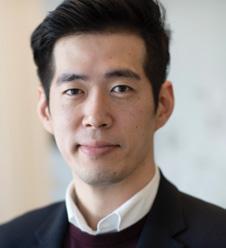
“It is important for school nurses to have the supports to be able to address the issues that chronically absent students face,” says Lee. “Ensuring an adequate number of certified school nurses in schools is a start. School nurses need more support from school districts to respond to the myriad of individual, family, and systems-level challenges that chronically absent students face. School nurses and school districts can also work with key stakeholders including parents, community organizations, and health care providers to create a coordinated strategy for school health.”
Study authors conducted focus groups with 21 school nurses from urban, suburban and rural areas of Minnesota, in collaboration with the Minnesota Youth Sex Trading collaborative. Nurses identified several barriers and facilitators related to school absenteeism including students’ physical health, mental health, family circumstances, access to transportation, housing instability and food insecurity. Nurses described how undiagnosed, untreated, or uncontrolled mental health issues significantly contributed to absenteeism, and how families or school systems often inadequately addressed students' mental health concerns.
44 | MINNESOTA NURSING
DIRECTOR:
PhD, RN, FAAN, FSAHM CENTER FOR
Knoo Lee
DIRECTOR: Teddie Potter, PhD, RN, FAAN, FNAP
CENTER FOR
PLANETARY HEALTH AND ENVIRONMENTAL JUSTICE
Preventing harm from happening
At the end of January, my husband took a bike ride wearing shorts. MinnesotaJanuary-shorts! How will Minnesota’s abnormal winter impact the upcoming summer? This question reflects systems and complexity, a core domain of planetary health knowledge.
The School of Nursing’s Center for Planetary Health and Environmental Justice is committed to teaching and studying the five core domains of planetary health. These include Interconnection Within Nature, the Anthropocene and Health, Equity and Social Justice, Systems Thinking and Complexity, and Movement Building and Systems Change. Learn more about the framework at planetaryhealthalliance.org.
Systems thinking means we recognize that changes have consequences. Very little or no snow can adversely affect farmers and impact water levels in rivers and lakes. Plants may bloom earlier and that can impact the behaviors of birds, insects and other pollinators. Everything is interconnected in one remarkable complex system. Change one part of the system and the rest of the system often responds in unexpected ways.

What do these changes have to do with nursing? Everything! Humans are embedded in the ecosystem, and what happens to one part of the system, impacts all parts of the system. This year we may need to be prepared for a warmer and drier summer, more wildfires, and more bugs. Even though it is May, we need to be teaching people about how to track air quality, the need to stay well-hydrated, and how to dress to avoid mosquitos and ticks.
Nursing is at its best when we prevent harm from happening. Humans are disrupting the Earth’s natural systems and as complex changes occur, the Center for Planetary Health and Environmental Justice will be ready to inform, prepare, and protect human health and safeguard the wellbeing of future generations.
www.nursing.umn.edu | 45
DIRECTORS:
Robin Austin, PhD, DNP, DC, RN-BC, FAMIA, FNAP
Connie Delaney, PhD, RN, FACMI, FAAN, FNAP
Martin Michalowski, PhD, FAMIA
CENTER FOR NURSING INFORMATICS
Nursing informatics, innovation empower nurses
In the dynamic landscape of health care, the need for nursing innovation and informatics has never been more pressing. As frontline caregivers, nurses are entrusted with the monumental task of delivering safe, effective and patient-centered care amidst an evolving health care ecosystem. Innovation in nursing, coupled with informatics, provides the essential tools and strategies to navigate this complexity seamlessly.
By harnessing technological advancements and datadriven insights, nurses can optimize workflows, enhance clinical decision-making, and elevate the overall quality of care delivery. From electronic health records (EHR) systems that streamline documentation to predictive analytics and artificial intelligence (AI) tools that anticipate patient needs, nursing informatics empowers nurses with the information they need to deliver timely interventions and personalized care.
Nursing innovation fosters creativity and adaptability, enabling nurses to devise novel solutions to complex health care challenges. Ultimately, nursing innovation and informatics are not just a necessity; it's a strategic imperative to ensure that nurses remain at the forefront of health care transformation, driving positive outcomes for patients and communities alike.
Faculty at the Center for Nursing Informatics are leading these efforts as Professor Jenna Marquard, PhD, and Assistant Professor Robin Austin, PhD, DNP, DC, RNBC, FAMIA, FNAP, along with alum Ian Wolfe, PhD, and Elizabeth Umberfield, PhD, RN, Mayo Clinic, served on a panel for the Midwest Nursing Research Society Emerging Scholars luncheon related to artificial intelligence and nursing, Artificial Nursing? Artificial Intelligence in Nursing Practice and Research: Friend or Foe.
Upcoming conferences and opportunities:
• The 2024 Nursing Knowledge: Big Data Science Conference will be held June 5-7 in Minneapolis.
• Planting Seeds of Innovation will be held June 4 in Minneapolis.
If you would like more information about these initiatives please contact center faculty at quis0026@umn.edu.
DIRECTOR: Siobhan McMahon, PhD, MPH, GNP-BC
CENTER FOR
AGING SCIENCE AND CARE INNOVATION
ECHO program initiated during pandemic broadens its purpose, reach
In 2020, the National Nursing Home COVID-19 Action Network was launched by the Agency for Healthcare Research and Quality and the Institute for Healthcare Improvement to support nursing homes’ response to the devastating effect of COVID-19. This network included an Extension for Community Outcomes (ECHO), an all-teach, all-learn approach that focuses on peer-to-peer learning and collaborative problem-solving.
Topics during the 1-hour, biweekly meetings after the first 16 weeks of ECHO have expanded because of feedback from attendants. The focus on quality and infection prevention fundamentals in 2020 have been broadened to include issues on emerging policies and practices, such as those related to CBD/THC, cognitive assessment and support, and trauma-informed care.
Professor Christine Mueller, PhD, RN, FGSA, FAAN, and Associate Professor Siobhan McMahon, PhD, MPH, GNP-BC, members of the Center for Aging Science and Care Innovation, continue to serve as two of the leads of Minnesota Geriatrics ECHO.
Together with interprofessional partners, Terry McCarthy, MD, from the medical school, Rajean Moone, PhD, faculty director for long-term care administration in the College of Continuing and Professional Studies, Emily Escue, MD, from Hennepin Healthcare, Kari Everson, DNP, MHA, RN, PHN, LNHA, LALD, from Evercare Aging Services, Christina Cauble, MBA, LNHA, HSE, a geriatrics education specialist from the University of Minnesota School of Medicine, and Adam Suomala, MPA, the executive director for the Minnesota Leadership Council on Aging, they have developed and delivered ECHO meetings. The meetings include 30 to 60 long-term care administrators and clinician participants.
Whether exploring new mental health resources for staff or palliative care supports, the ECHO meetings focus on the sticky conversations where different perspectives can improve a shared understanding. In addition to broadening topics, Minnesota Geriatrics ECHO has also broadened its reach to include not only representatives from nursing homes but also representatives from assisted living organizations. Plans are to continue the Minnesota Geriatrics ECHO to support dynamic topics that drive quality improvement across long-term care settings. For more information or to learn how to join the conversation, visit the Minnesota Geriatrics ECHO website at www.mngeriatricsecho.org.
46 | MINNESOTA NURSING
DIRECTOR: Jayne Fulkerson, PhD
CENTER FOR CHILD AND FAMILY HEALTH PROMOTION RESEARCH
Examining the role of family in teen TikTok use and diet
Social media use is ubiquitous among teens and young adults. Nearly 3 of 5 teens report daily TikTok use and 2 of 5 report using it almost constantly. Exposure to and use of social media during a time of such critical physical, cognitive and emotional development can put teens in a vulnerable position. Social media has been linked to many adverse outcomes in teen mental and dietary health due to its idealized portrayals, displacement of other healthful activities and food marketing strategies. Although social media also has some positive impacts, little is known about how to protect teens from its harmful effects.
Parents could play an influential role in teen social media use that could counteract negative influences. Center member and PhD student Adrianna Bell, BSN, RN, PHN (adviser, Melissa Horning, PhD) is leading two studies examining the role of family in teen’s social media use over time. The research is funded by the University of Minnesota Doctoral Dissertation Fellowship and School of Nursing Sophia Grant. The first study assesses patterns of family closeness and mealtime characteristics in more than 1,200 adolescents and how their social media use and diet changed transitioning into young adulthood.
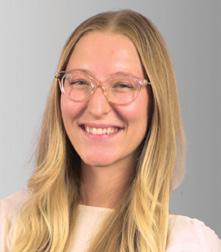
The second study includes four focus groups conducted at a local high school. The focus group study materials were reviewed by a Youth Advisory Board for relevance prior to recruitment, strengthening the relevance of the study to teens. Teens discussed how TikTok influenced their eating and the role of parental involvement in their TikTok use. Analyses for these studies are nearing completion. This novel research is the first to examine the role of family in teen social media use and diet. Results of these studies will highlight the critical role of parents in protecting adolescents from more social media use and lower dietary quality as they transition into young adulthood.
www.nursing.umn.edu | 47
Adrianna Bell
RECOGNIZE A CLASSMATE WITH AN ALUMNI SOCIETY AWARD
School of Nursing alumni are serving across the world to improve the health of all people and the planet. Do you know a School of Nursing alum who deserves to be recognized? The School of Nursing Alumni Society Board is now accepting nominations for three Alumni Society Awards through July 31. Recipients will be celebrated at the All School Reunion, held on Oct. 24 during Homecoming 2024.
The Rising Star Award honors a recent graduate with noteworthy success in their career, entrepreneurship, scholastic accomplishments and/or service.
The Distinguished Alumni Humanitarian Award celebrates a graduate for exceptional humanitarian service in a health care environment.
The Excellence in Practice Award recognizes a graduate who works with patients and clients, mentors and advocates for other nurses and strives to improve patient outcomes and safety.
To find out more and submit a nomination visit z.umn.edu/nursingalumniawards
CHANGE COMES TO ALUMNI EMAIL
To mitigate cybersecurity and data privacy risks, the University of Minnesota can no longer provide alumni with Google Workspace, which includes Gmail.
The University began offering email to graduates at a time when email was new and not widely available. Since that time, cyberattacks have become more sophisticated, and data storage needs and costs associated with licensing have grown dramatically.
To help with this transition, alumni received one year of transition time. Tools and instructions to download or transfer personal emails, contacts, and files, and support resources are available at https://z.umn.edu/UMNemail
To update your contact information with the School of Nursing, visit www.nursing.umn.edu/alumni
48 | MINNESOTA NURSING ALUMNI NEWS
CLASS NOTES
Faith Kidder, MS ’97, BSN ’88, received the 2023 Betty Hubbard Maternal and Child Health Statewide Leadership Award for statewide contributions to maternal and child health in Minnesota. The award was presented by the Minnesota Department of Health Commissioner and the Maternal and Child Health Advisory Task Force.
Larry Asplin, MS ’00, BSN ’97, was named a Fellow of the Association of periOperative Registered Nurses. He also received the 2023 Outstanding Volunteer Leadership Award from the Association of periOperative Registered Nurses.
Roxanna Gapstur, PhD '10 has been named to the Central Pennsylvania Business Journal’s Power 100 List for the fourth year.
Jonathan Pritchard, MN ’10, was appointed chief of the Cottage Grove Fire Department.
IN MEMORY
Marian T O'Hara, BSN '47
Joyce Van Rossum, BSN '47
Miriam S. Kiser, BSN ’48
Irene Johnson, BSN ’48
Evelyn Nelson, BSN ’50
Ramona Rosemeier, BSN ’53
Kathleen M. Broman, BSN '57
Patricia Tomlinson, BSN ’57
Ruth Irene Davidson, MSN ’59
Rebecca R. Fry, BSN ’59
Matthew Baehr, BSN ’14, started a new role as senior manager, Business Development & Strategic Planning at UT Health San Antonio.
Julie Sabo, PhD ’16, received the 2023 Advocate State Award for Excellence from the American Academy of Nurse Practitioners.
Razaq Adedayo, DNP ’17, MN ’12, was selected as the director of Nursing for the Minneapolis Veterans Home.
Alejandra Eppinger, DNP ’17, MN ’11, is a pediatric nurse practitioner and the director of Southside Community Health Services, which is expanding pediatric care services as the only clinic awarded the Early Childhood Development Grant through the Health Resources and Services Administration in Minnesota.
Kelsey O'Neil, DNP '23, joined Essentia Health-Duluth Clinic as an advanced practice registered nurse and certified nurse practitioner specializing in obstetrics and gynecology.
Adam Karlen, DNP ’21, started a new role as vice president/chief nursing officer at M Health Fairview Southdale.
Darby Schmidt, DNP ’23, joined the Essentia Health-Duluth Clinic as an advanced practice registered nurse and certified nurse practitioner specializing in cardiology.
KEEP US UP TO DATE
Have you recently received a promotion, hired for a new position or honored with an award? Or have you moved or changed email addresses? Keep us up to date and let us know by visiting www.nursing.umn.edu/alumni.
Marian E. Gruenfelder, BSN ’59
Edna S. Mukai, BSN ’59
Betty Lia-Hoagberg, BSN ’61
Arline D. Hellekson, BSN '62
Joanne Schouten, BSN ’62
Donna B. Hambleton, BSN ’67
Betsey S. Bittle Woodward, BSN ’67
Donna B. Hambleton, BSN ’67
Laura C Iverson, BSN '70
Carol Hoffman, MSN ’74
Margaret A. Plumbo, MSN ’78
Jo Etta A Vernon, MSN ’80, BSN ’79
Sandra F Fritz-Kelly, MSN ’82
Beth P. Johnson, MSN '83
Judith M Gardner, MSN ’84
Rita Kelly, BSN ’86
Marjorie D Weiss, PhD ’91
Joy M Alexander, MSN ’99
Linda D Warnest, MSN ’02
www.nursing.umn.edu | 49
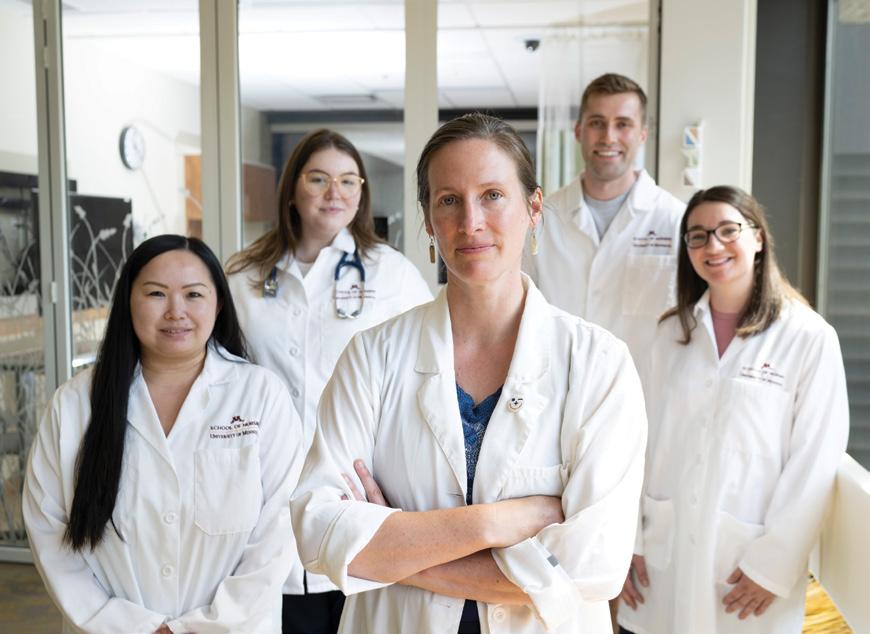
STRUCTURED FOR YOUR SUCCESS
Want to transform your career and the health care system but don’t have the tools to do so?
Become a full-practice provider and an innovative systems leader with a Doctor of Nursing Practice (DNP) degree from the University of Minnesota.
• Co-created learning experiences in one of 12 specialties
• Hybrid-by-design program that maximizes education with flexibility
• Worry-free and relevant practicum placements with trusted preceptors
• Support from faculty advisers deeply invested in your future, dedicated professional academic staff and our strong alumni network
Learn more and apply at z.umn.edu/DNP

50 | MINNESOTA NURSING
BAYARD, SCHROEDER NAMED INAUGURAL RECIPIENTS OF THE ELVA WALKER SPILLANE PHILANTHROPIC LEADERSHIP AWARD
Carolyn Iverson Schroeder, BSNE ‘55, and Jeannine Bayard, BSN ‘71, were named the inaugural recipients of the Elva Walker Spillane Philanthropic Leadership Award, which was created to recognize examples of a life committed to the betterment of others.
Named in honor and celebrating the spirit of the first chair of the School of Nursing Foundation Board of Trustees and conferred by the dean, the award will be bestowed to individuals whose leadership, service and philanthropy have transformed the School of Nursing.
In the early 1950s Schroeder enrolled at the University of Minnesota, where during her studies in nursing education she met a business and law student, the late Clinton A. Schroeder, ‘55. The two wed in 1953. After graduating with a bachelor’s degree in nursing education, she became a staff nurse at what is now M Health Fairview University of Minnesota Medical Center, earning a stellar reputation as a clinician in surgical nursing and other care areas. “A degree from the University of Minnesota School of Nursing just opens the doors to hundreds of experiences with the best people, ideas and cutting-edge opportunities in
the field,” she says. Schroeder has remained a lifelong advocate for health care and nursing, especially the health care of children.
Schroeder, while partnering with her husband to raise five bright and active children, was an engaged community leader, mission advocate and philanthropic visionary. She helped found and amplify numerous nonprofit missions, including what is now Children’s Minnesota. Elva Walker Spillane herself recruited Schroeder to be an early member of the School of Nursing Foundation Board of Trustees. While serving as a trustee, Schroeder led the fundraising initiative for the Katharine J. Densford International Center for Nursing Leadership, and she chaired the School of Nursing’s participation in the University’s system-wide fundraising campaign, Campaign Minnesota. As chair and a major donor of the school’s campaign, she motivated volunteers to surpass their fundraising goal in record time. In fact, thanks in part to Schroeder, the University was the first organization in Minnesota to raise $1 billion in gifts through a fundraising campaign.
“I am honored to receive this award because I have valued all of my experiences and the associations over the years that I have had with our donors and the friends of the School of Nursing, who have done so much to make our philanthropic success possible,” Schroeder says.
continued on page 52
www.nursing.umn.edu | 51
GIVING

 Jeannine Bayard
Jeannine Bayard
continued from page 51
Bayard, a nursing visionary, co-developed Evercare, a revolutionary long-term care model with a nurse practitioner as the center of an integrated care team. All the while, she was giving back to her alma mater by serving multiple terms as the chair of the school’s Foundation Board of Trustees, a member of the Dean’s National Board of Visitors, and co-chair of the Empowering Health campaign, which raised $47 million for nursing education, research, faculty chairs and professorships. There was little question as to how Bayard wanted to improve nursing education by establishing a scholarship. “When visiting medical offices as a patient, I would meet medical and nursing assistants who are really interested in nursing careers,” Bayard
says. “However, their experience with student debt can make this dream feel impossible. I wanted to help make their career pursuits possible through philanthropy, and I wanted to inspire other donors to do the same.”
Equally important, she aimed to help the school better reflect the diversity found in Minnesota, the nation and the world. “Thinking back on my years as a nursing student, most of the students and faculty looked like me — white, cisgender females — and we came from similar backgrounds,” Bayard says. “For this reason, I never considered a general scholarship because I know how important it is for patients and colleagues to see nurses who look like them and share their cultural experiences.”
52 | MINNESOTA NURSING
Carolyn Iverson Schroeder
“A degree from the University of Minnesota School of Nursing just opens the doors to hundreds of experiences with the best people, ideas and cutting-edge opportunities in the field.”
– Carolyn Iverson Schroeder
In 2018, Bayard established The School of Nursing Endowed Scholarship for Inclusivity. It is the school's first-ever full scholarship for students who enhance the diversity of the student body, as defined by the University. The scholarship is designed to support a student in all four of the school’s degree programs, sequentially. It will benefit students in perpetuity, with the award amount increasing over time.
“Everyone who knows me, knows that I am a University of Minnesota nurse,” Bayard says. “I am honored to receive this award and, more importantly, to have been given the opportunity to pave the way for the school’s future generations.” • • •
SCHOOL OF NURSING FOUNDATION BOARD OF TRUSTEES
Matthew Baehr
UTHealth San Antonio
Jane Bagley
St. Cloud State University
Kelsey Derrick
St. Croix Hospice
Mark Ebeling
M Health Fairview
U.S. Army, Retired
Allysia Jenkins
Treasurer/Secretary
Humana
Cynthia Jurgensen
UnitedHealth Group, Retired
Adam Karlen
M Health Fairview
Meri Beth Kennedy
Planned Parenthood North Central States, Retired
Kelly Landsman
Landsman Engineering LLC
Lisa Martin University of Minnesota School of Nursing
Christine Mueller
Faculty Representative University of Minnesota School of Nursing
Marjorie Page
Chair
M Health Fairview, Retired
David Piper
State of Minnesota, Retired
Ben Ranstrom
CentraCare and North Memorial
David Rothenberger
University of Minnesota Medical School
Sharyn Salmen
Salmen Consulting, Retired
Naomi Thomas Minneapolis College
Nancy DeZellar Walsh Past Chair
DeZellar Walsh Consulting LLC
EX-OFFICIO MEMBERS (WITH VOTING PRIVILEGES)
Connie White Delaney Professor and Dean
University of Minnesota School of Nursing
Andrew McIlree
Director of Development & Alumni Relations
University of Minnesota School of Nursing
Savannah Zins
Alumni Society Board
Representative Mayo Clinic
www.nursing.umn.edu | 53
PHOTO FINISH

BSN student Shivani Muthya received first place for her poster Food Pricing Inequities: Quantifying the Price Differential across Four Major Food Retailers and a Mobile Food Market Aiming to Improve Access to Affordable Nutritious Food at the Midwest Nursing Research Society Conference in Minneapolis.
Eight Bachelor of Science in Nursing students studied abroad at the University of Limerick in Ireland during the fall semester. They completed nursing courses, liberal education requirements and traveled to the Aran Islands.

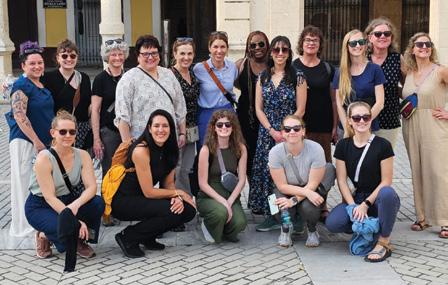
Doctor of Nursing Practice students and faculty traveled to Cuba to learn about the national health care model based primarily in prevention.
SCHOOL NEWS
54 | MINNESOTA NURSING
The school celebrated the graduation of students in the Master of Nursing, Doctor of Nursing Practice, and PhD programs at a commencement ceremony in December.
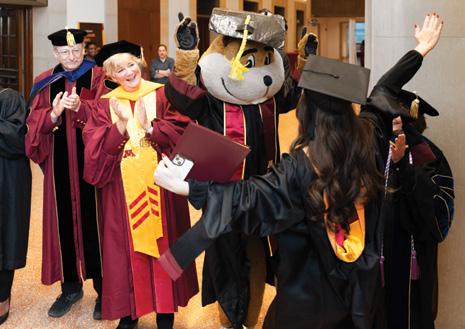

Regents Mary Turner and Penny Wheeler explore the virtual reality simulations that are being utilized by Bachelor of Science in Nursing students, while PhD student Marshall Muehlbauer explains the scenarios.
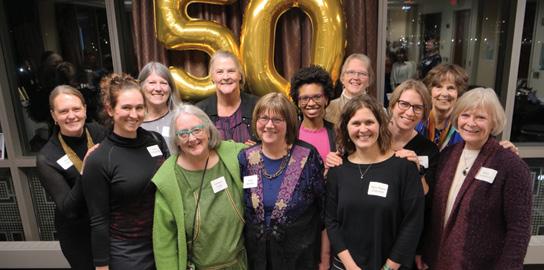
A half-century ago, the University of Minnesota School of Nursing established the first nurse-midwifery program in Minnesota. Nurse-midwives and students gathered in February to celebrate the anniversary.
www.nursing.umn.edu | 55
www.nursing.umn.edu |
PHOTO FINISH
5-140

Nonprofit Org. U.S. Postage PAID Twin Cities, MN Permit No. 90155
Weaver Densford Hall 308 Harvard Street S.E. Minneapolis, MN 55455 www.nursing.umn.edu




















































 Jeannine Bayard
Jeannine Bayard






